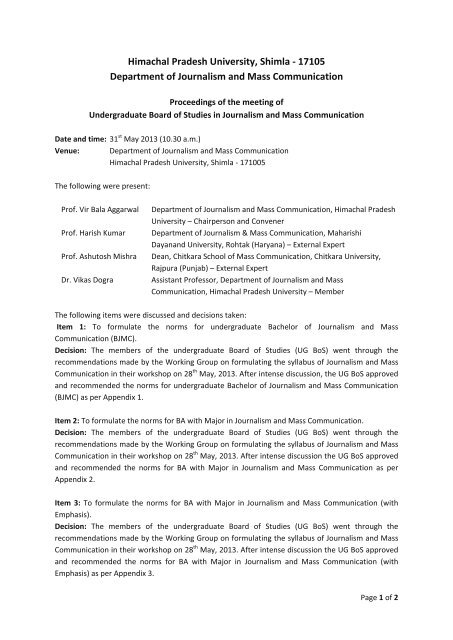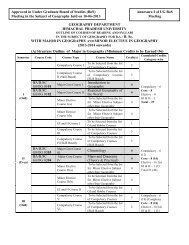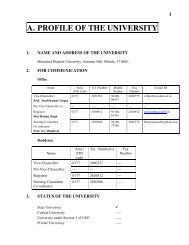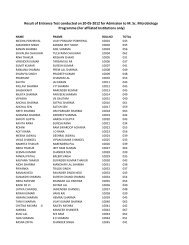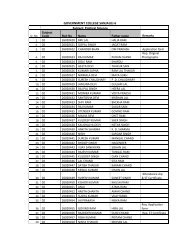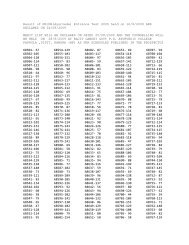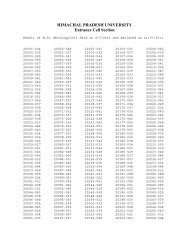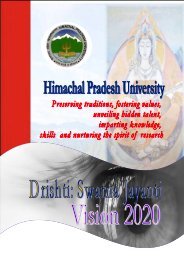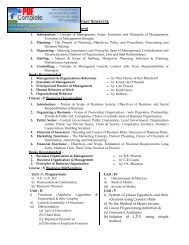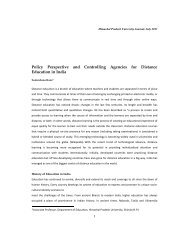Detailed Syllabus- Outline, End Term Exam Guidelines, Structure, etc.
Detailed Syllabus- Outline, End Term Exam Guidelines, Structure, etc.
Detailed Syllabus- Outline, End Term Exam Guidelines, Structure, etc.
- No tags were found...
Create successful ePaper yourself
Turn your PDF publications into a flip-book with our unique Google optimized e-Paper software.
HimachalPradeshUniversity,Shimla17105DepartmentofJournalismandMassCommunicationProceedingsofthemeetingofUndergraduateBoardofStudiesinJournalismandMassCommunicationDateandtime:31 st May2013(10.30a.m.)Venue: DepartmentofJournalismandMassCommunicationHimachalPradeshUniversity,Shimla171005Thefollowingwerepresent:Prof.VirBalaAggarwal DepartmentofJournalismandMassCommunication,HimachalPradeshUniversity–ChairpersonandConvenerProf.HarishKumar DepartmentofJournalism&MassCommunication,MaharishiDayanandUniversity,Rohtak(Haryana)–ExternalExpertProf.AshutoshMishra Dean,ChitkaraSchoolofMassCommunication,ChitkaraUniversity,Rajpura(Punjab)–ExternalExpertDr.VikasDogra AssistantProfessor,DepartmentofJournalismandMassCommunication,HimachalPradeshUniversity–Member Thefollowingitemswerediscussedanddecisionstaken:Item 1: To formulate the norms for undergraduate Bachelor of Journalism and MassCommunication(BJMC).Decision: The members of the undergraduate Board of Studies (UG BoS) went through therecommendationsmadebytheWorkingGrouponformulatingthesyllabusofJournalismandMassCommunicationintheirworkshopon28 th May,2013.Afterintensediscussion,theUGBoSapprovedandrecommendedthenormsforundergraduateBachelorofJournalismandMassCommunication(BJMC)asperAppendix1.Item2:ToformulatethenormsforBAwithMajorinJournalismandMassCommunication.Decision: The members of the undergraduate Board of Studies (UG BoS) went through therecommendationsmadebytheWorkingGrouponformulatingthesyllabusofJournalismandMassCommunicationintheirworkshopon28 th May,2013.AfterintensediscussiontheUGBoSapprovedand recommended the norms for BA with Major in Journalism and Mass Communication as perAppendix2.Item 3: To formulate the norms for BA with Major in Journalism and Mass Communication (withEmphasis).Decision: The members of the undergraduate Board of Studies (UG BoS) went through therecommendationsmadebytheWorkingGrouponformulatingthesyllabusofJournalismandMassCommunicationintheirworkshopon28 th May,2013.AfterintensediscussiontheUGBoSapprovedand recommended the norms for BA with Major in Journalism and Mass Communication (withEmphasis)asperAppendix3.Page1of2
AbbreviationsUnlessotherwisespecified,abbreviationswithfollowingmeaningshavebeenusedinAppendices1to7:BA:BachelorofArtsBJMC:BachelorofJournalismandMassCommunicationBoS:BoardofStudiesCCA:ContinuousComprehensiveAssessmentESE:<strong>End</strong>semester<strong>Exam</strong>inationGI&H:GeneralInterestandHobbyCoursesHC:HardCoreCourseJMC:JournalismandMassCommunicationL:LectureSessioncreditsOE:OpenElectivecourseP:Practical/PracticeSessioncreditsSC:SoftCorecourseT:TutorialSessioncredits
1Appendix1HimachalPradeshUniversity,Shimla–171005DepartmentofJournalismandMassCommunicationNormsforundergraduateBachelorofJournalismandMassCommunication(BJMC)ApprovedbyundergraduateBoardofStudiesinJournalismandMassCommunicationon31 st May,2013.Sd/Prof.HarishKumarDepartmentofJournalism&MassCommunication,MaharishiDayanandUniversity,Rohtak–ExternalExpertSd/Prof.AshutoshMishraDean,ChitkaraSchoolofMassCommunication,ChitkaraUniversity,Rajpura–ExternalExpertSd/Dr.VikasDograAssistantProfessor,DepartmentofJournalismandMassCommunication,HimachalPradeshUniversityMemberSd/Prof.VirBalaAggarwalDepartmentofJournalismandMassCommunication,HimachalPradeshUniversity–ChairpersonandConvener
2BachelorofJournalismandMassCommunication(BJMC)Requirements:20132014onwards1. Astudentshallhavetoearnaminimumof120creditsfortheDegreeofBachelorofJournalismandMassCommunication(BJMC).2. ThesecreditsmaybeearnedfromacombinationofCompulsory,HardCore,SoftCore,ElectiveCoursesandGeneralInterestandHobbycoursesasfollows:Sr. ProgrammeComponent SubjectofStudyMinimumCreditstobeearnedi. HardCoreCourses * JMC^ 28ii. SoftCoreCourses @ JMC^ 28iii. Minor1 $ JMC^ 20iv. Minor2 Anystream v. CompulsoryCourses Any 9vi. GeneralInterestandHobby Any 1vii. AdditionalCore/Elective Anystream # Variable~Total120^ThesubjectofJournalismandMassCommunicationisabbreviatedasJMC.*AllHardCorecourseshavetobecompulsorilytakenup.@SoftCorecoursesmayalsobechosenasAdditionalCorecoursesforearningadditionalcredits.$ ForMinorinJMC,astudentmaychoosefromOpenElectivecoursesofferedbyJournalismandMassCommunicationDepartment. Astudentmayoptfor2 nd MinorfromanystreamotherthanJMCfromthechoicesofferedbytheinstitutionofstudy.Asperrequirementsofthesubject.Coursestobechosenfromtherespectivelistofoptionsofferedbytheinstitutionofstudy.#A student may choose Additional Core/Elective courses either fromJMCorthe2 nd Minorsubjectoptedforbyhim/her.~ Astudentshouldchooseadditionalcore/electivesinsuchawaythat(s)hemayearnaminimumof120creditsforthedegreeofBJMC.3. CandidatesadmittedtoBJMCfromtheyear201314maytakeupcoursesaspertheindicativeUndergraduate Programme Course <strong>Structure</strong> for BA with Major in Journalism and MassCommunicationenclosed.4. StudentsofBJMCcannotoptforCompulsorycoursesinJMC.5. In addition to the above, the students of BJMC shall be governed by the general rules andregulations for admission, selection of courses, scheme of examinations, programmerequirements,<strong>etc</strong>.asdecidedbytheHimachalPradeshUniversity,Shimlafromtimetotime.
3AnindicativeUndergraduateProgrammeCourse<strong>Structure</strong>forBachelorofJournalismandMassCommunication(BJMC)(Forthecandidatestobeadmittedfromtheyear201314)Semester CourseCode CourseType CourseName Credits CumulatedcreditsCategorywise # I(Odd)CompulsoryCourseITobeselectedfromthelistofCompulsorycourses3Compulsory–6Core–8Elective–8GI&H–1Total–23CompulsoryCourseII(Skillbased)TobeselectedfromthelistofCompulsorycourses(Skillbased)3BJMC110401MajorCoreCourseIPrinciplesofCommunication4BJMC110402MajorCoreCourseIIJournalism,EthicsandSociety4BJMC110403/BJMC110404MinorElectiveCourseI(a)NewsWritingSkills/Reporting,EditingandFeatureWriting4MinorElectiveCourseI(b)TobeselectedfromlistofMinorElectivesubjectsotherthanJMC4GI&HCourseITo beselectedfromthelistofGI&Hcourses1II(Even)CompulsoryCourseIIITobeselectedfromthelistofCompulsorycourses3Compulsory–6Core–8Elective–8GI&H–1Total–23CompulsoryCourseIV(Skillbased)TobeselectedfromthelistofCompulsorycourses(Skillbased)3BJMC120405MajorCoreCourseIIIUnderstandingTelevision4BJMC120406MajorCoreCourseIVUnderstandingRadio4BJMC120407/BJMC120408MinorElectiveCourseII(a)WritingandProducingforRadio/WritingandProducingforTelevision4MinorElectiveCourseII(b)TobeselectedfromlistofMinorElectivesubjectsotherthanJMC4GI&HCourseIITobeselectedfromthelistofGI&Hcourses1III(Odd)CompulsoryCourseVTobeselectedfromthelistofCompulsorycourses(Skillbased)3Compulsory–6Core–12Elective–8GI&H–1Total–27CompulsoryCourseVI(Skillbased)TobeselectedfromthelistofCompulsorycourses(Skillbased)3BJMC210401MajorCoreCourseVNewMediaCommunication4BJMC210402MajorCoreCourseVIIntroductiontoAdvertising4BJMC210403MajorCoreCourseVIIIntroductiontopublicRelations4BJMC210404/BJMC210405MinorElectiveCourseIII(a)NewMediaWritingandPublishing/InterpersonalCommunicationSkills4MinorElectiveCourseIII(b)TobeselectedfromlistofMinorElectivesubjectsotherthanJMC4GI&HCourseIIITobeselectedfromthelistofGI&Hcourses1
4Semester CourseCode CourseType CourseName Credits CumulatedcreditsCategorywise #IV(Even)BJMC220406MajorCoreCourseVIIICommunicationandDevelopment4Core–12Elective–8Core/Elective(additional)–4Total–24BJMC220407MajorCoreCourseIXCommunityandTraditionalMedia4BJMC220408MajorCoreCourseXMediaandCulture4BJMC220409/BJMC220410MinorElectiveCourseIV(a)NewspaperOrganisationandFunctioning/UnderstandingFilms4MinorElectiveCourseIV(b)TobeselectedfromlistofMinorElectivesubjectsotherthanJMC4Core/Elective(Additional)*AnyoneoftheCore/Additional/OpenElectivecourses4V(Odd)BJMC310401MajorCoreCourseXIMassMediaResearch4Core–12Elective–8Core/Elective(additional)–4Total–24BJMC310402MajorCoreCourseXIIIntroductiontoVisualCommunication4BJMC310405MajorCoreCourseXIIIGlobalCommunication4BJMC310403/BJMC310404MinorElectiveCourseV(a)GraphicDesignandProduction/Photojournalism4MinorElectiveCourseV(b)To beselectedfromlistofMinorElectivesubjectsotherthanJMC4Core/Elective(Additional)*AnyoneoftheCore/Additional/OpenElectivecourses4VI(Even)BJMC320806MajorCoreCourseXIVMediaInternship8Core–16Core/Elective(additional)–20Total–36BJMC320807MajorCoreCourseXVMediaProject8Core/Elective(Additional)*AnyoneoftheCore/Additional/OpenElectivecourses4Core/Elective(Additional)*AnyoneoftheCore/Additional/OpenElectivecourses4Core/Elective(Additional)*AnyoneoftheCore/Additional/OpenElectivecourses4Core/Elective(Additional)*AnyoneoftheCore/Additional/OpenElectivecourses4Core/Elective(Additional)*AnyoneoftheCore/Additional/OpenElectivecourses4*Additionalcore/electivecoursescanbetakenintheIVtoVIsemestersfor‘SecondMajor’orforearningadditionalcreditsasthecasemaybe.# Thetotalandcategorywisecreditsthatastudentcanearnineachsemesterisonlyindicative.Thenumberofcreditsearnedbyastudentpersemestermayvary.Thiswillhoweverbesubjecttotherequirementsoftheprogrammeofstudyalongwithrulesandregulationsoftheinstitutionofstudy.
5Appendix2HimachalPradeshUniversity,Shimla–171005DepartmentofJournalismandMassCommunicationNormsforBAwithMajorinJournalismandMassCommunicationApprovedbyundergraduateBoardofStudiesinJournalismandMassCommunicationon31 st May,2013.Sd/Prof.HarishKumarDepartmentofJournalism&MassCommunication,MaharishiDayanandUniversity,Rohtak–ExternalExpertSd/Prof.AshutoshMishraDean,ChitkaraSchoolofMassCommunication,ChitkaraUniversity,Rajpura–ExternalExpertSd/Dr.VikasDograAssistantProfessor,DepartmentofJournalismandMassCommunication,HimachalPradeshUniversityMemberSd/Prof.VirBalaAggarwalDepartmentofJournalismandMassCommunication,HimachalPradeshUniversity–ChairpersonandConvener
6BAwithMajorinJournalismandMassCommunicationRequirements:20132014onwards1. A student shall have to earn a minimum of 120 credits for BA with Major in Journalism andMassCommunication.2. ThesecreditsmaybeearnedfromacombinationofCompulsory,HardCore,SoftCore,ElectiveandGeneralInterestandHobbycoursesasfollows:Sr. ProgrammeComponent SubjectofStudyMinimumCreditstobeearnedi. HardCoreCourses * JMC^ 28ii. SoftCoreCourses @ JMC^ 28iii. Minor1 Anystream $ iv. Minor2 Anystream $ v. CompulsoryCourses Any 9vi. GeneralInterestandHobby Any 1vii. AdditionalCore/Elective Anystream # Variable~Total120^ThesubjectofJournalismandMassCommunicationisabbreviatedasJMC.*AllHardCorecoursesinJMChavetobecompulsorilytakenup.@SoftCorecoursesmayalsobechosenasAdditionalCorecoursesforearningadditionalcredits.$ Astudentmayoptfor1 st and2 nd MinorsubjectsfromanystreamotherthanJMC.Thesesubjectsaretobeselectedfromtheoptionsofferedbytheinstitutionofstudy.Asperrequirementsofthesubjectchosen.Suchcourseshavetobechosenfromtherespectiveoptionsofferedbytheinstitutionofstudy.#A student may choose Additional Core/Elective courses from JMC orMinor1orMinor2subjectsoptedforbyhim/her.~ AstudentshouldchooseAdditionalCore/Electivesinsuchawaythat(s)he may earn a minimum of 120 credits for the degree of BA withMajorinJournalismandMassCommunication.3. CandidatesadmittedtoBAwithMajorinJMCfromtheyear201314maytakeupcoursesaspertheindicativeUndergraduateProgrammeCourse<strong>Structure</strong>forBAwithMajorinJournalismandMassCommunicationenclosed.4. StudentsofpursuingMajorinJMCcannotoptforCompulsorycoursesinJMC.5. In addition to the above, the students of BJMC shall be governed by the general rules andregulations for admission, selection of courses, scheme of examinations, programmerequirements,<strong>etc</strong>.asdecidedbytheHimachalPradeshUniversity,Shimlafromtimetotime.
7AnindicativeUndergraduateProgrammeCourse<strong>Structure</strong>forBAwithMajorinJournalismandMassCommunication(BJMC)(Forthecandidatestobeadmittedfromtheyear201314)Semester CourseCode CourseType CourseName Credits CumulatedcreditsCategorywise # I(Odd)CompulsoryCourseITobeselectedfromthelistofCompulsorycourses3Compulsory–6Core–8Elective–8GI&H–1Total–23CompulsoryCourseII(Skillbased)TobeselectedfromthelistofCompulsorycourses(Skillbased)3BJMC110401MajorCoreCourseIPrinciplesofCommunication4BJMC110402MajorCoreCourseIIJournalism,EthicsandSociety4MinorElectiveCourseI(a)TobeselectedfromlistofMinorElectivesubjectsotherthanJMC4MinorElectiveCourseI(b)TobeselectedfromlistofMinorElectivesubjectsotherthanJMC4GI&HCourseITobeselectedfromthelistofGI&Hcourses1II(Even)CompulsoryCourseIIITobeselectedfromthelistofCompulsorycourses3Compulsory–6Core–8Elective–8GI&H–1Total–23CompulsoryCourseIV(Skillbased)TobeselectedfromthelistofCompulsorycourses(Skillbased)3BJMC120405MajorCoreCourseIIIUnderstandingTelevision4BJMC120406MajorCoreCourseIVUnderstandingRadio4MinorElectiveCourseII(a)TobeselectedfromlistofMinorElectivesubjectsotherthanJMC4MinorElectiveCourseII(b)TobeselectedfromlistofMinorElectivesubjectsotherthanJMC4GI&HCourseIITobeselectedfromthelistofGI&Hcourses1III(Odd)CompulsoryCourseVTobeselectedfromthelistofCompulsorycourses(Skillbased)3Compulsory–6Core–12Elective–8GI&H–1Total–27CompulsoryCourseVI(Skillbased)TobeselectedfromthelistofCompulsorycourses(Skillbased)3BJMC210401MajorCoreCourseVNewMediaCommunication4BJMC210402MajorCoreCourseVIIntroductiontoAdvertising4BJMC210403MajorCoreCourseVIIIntroductiontopublicRelations4MinorElectiveCourseIII(a)TobeselectedfromlistofMinorElectivesubjectsotherthanJMC4MinorElectiveCourseIII(b)TobeselectedfromlistofMinorElectivesubjectsotherthanJMC4GI&HCourseIIITobeselectedfromthelistofGI&Hcourses1
8Semester CourseCode CourseType CourseName Credits CumulatedcreditsCategorywise #IV(Even)BJMC220406MajorCoreCourseVIIICommunicationandDevelopment4Core–12Elective–8Core/Elective(additional)–4Total–24BJMC220407MajorCoreCourseIXCommunityandTraditionalMedia4BJMC220408MajorCoreCourseXMediaandCulture4MinorElectiveCourseIV(a)TobeselectedfromlistofMinorElectivesubjectsotherthanJMC4MinorElectiveCourseIV(b)TobeselectedfromlistofMinorElectivesubjectsotherthanJMC4Core/Elective(Additional)*AnyoneoftheCore/Additional/OpenElectivecourses4V(Odd)BJMC310401MajorCoreCourseXIMassMediaResearch4Core–12Elective–8Core/Elective(additional)–4Total–24BJMC310402MajorCoreCourseXIIIntroductiontoVisualCommunication4BJMC310405MajorCoreCourseXIIIGlobalCommunication4MinorElectiveCourseV(a)TobeselectedfromlistofMinorElectivesubjectsotherthanJMC4MinorElectiveCourseV(b)TobeselectedfromlistofMinorElectivesubjectsotherthanJMC4Core/Elective(Additional)*AnyoneoftheCore/Additional/OpenElectivecourses4VI(Even)BJMC320806MajorCoreCourseXIVMediaInternship8Core–16Core/Elective(additional)–20Total–36BJMC320807MajorCoreCourseXVMediaProject8Core/Elective(Additional)*AnyoneoftheCore/Additional/OpenElectivecourses4Core/Elective(Additional)*AnyoneoftheCore/Additional/OpenElectivecourses4Core/Elective(Additional)*AnyoneoftheCore/Additional/OpenElectivecourses4Core/Elective(Additional)*AnyoneoftheCore/Additional/OpenElectivecourses4Core/Elective(Additional)*AnyoneoftheCore/Additional/OpenElectivecourses4*Additionalcore/electivecoursescanbetakenintheIVtoVIsemestersfor‘MajorwithEmphasis’,‘SecondMajor’orforearningadditionalcreditsasthecasemaybe.# Thetotalandcategorywisecreditsthatastudentcanearnineachsemesterisonlyindicative.Thenumberofcreditsearnedbyastudentpersemestermayvary.Thiswillhoweverbesubjecttotherequirementsoftheprogrammeofstudyalongwithrulesandregulationsoftheinstitutionofstudy.
9Appendix3HimachalPradeshUniversity,Shimla–171005DepartmentofJournalismandMassCommunicationNormsforBAwithMajorinJournalismandMassCommunication(withEmphasis)ApprovedbyundergraduateBoardofStudiesinJournalismandMassCommunicationon31 st May,2013.Sd/Prof.HarishKumarDepartmentofJournalism&MassCommunication,MaharishiDayanandUniversity,Rohtak–ExternalExpertSd/Prof.AshutoshMishraDean,ChitkaraSchoolofMassCommunication,ChitkaraUniversity,Rajpura–ExternalExpertSd/Dr.VikasDograAssistantProfessor,DepartmentofJournalismandMassCommunication,HimachalPradeshUniversityMemberSd/Prof.VirBalaAggarwalDepartmentofJournalismandMassCommunication,HimachalPradeshUniversity–ChairpersonandConvener
10BAwithMajorinJournalismandMassCommunication(withEmphasis)Requirements:20132014onwards1. AstudentpursuingBAwithMajorinJournalismandMassCommunicationwillbeeligibleforBAwithMajorinJournalismandMassCommunication(withemphasis)if(s)heaccruesatleast15creditsinexcessoftheminimumrequirementof120credits.2. These15creditsinexcesswillhavetobeearnedwithatleast‘A’gradeinJMCcourses.3. Such students may opt for Core/Open Elective courses in JMC as Additional Core/ElectiveCourses.4. SuchstudentscannotoptforCompulsorycoursesinJMC.5. Allothernormsforsuch studentshallremainthe sameasforthestudentspursuingBAwithMajorinJournalismandMassCommunication6. In addition to the above, the students pursuing BA with Major in Journalism and MassCommunication (with emphasis) shall be governed by the general rules and regulations foradmission, selection of courses, scheme of examinations, programme requirements, <strong>etc</strong>. asdecidedbytheHimachalPradeshUniversity,Shimlafromtimetotime.
11Appendix4HimachalPradeshUniversity,Shimla–171005DepartmentofJournalismandMassCommunicationNormsforoptingforJournalismandMassCommunicationasaMinorinundergraduateprogrammesApprovedbyundergraduateBoardofStudiesinJournalismandMassCommunicationon31 st May,2013.Sd/Prof.HarishKumarDepartmentofJournalism&MassCommunication,MaharishiDayanandUniversity,Rohtak–ExternalExpertSd/Prof.AshutoshMishraDean,ChitkaraSchoolofMassCommunication,ChitkaraUniversity,Rajpura–ExternalExpertSd/Dr.VikasDograAssistantProfessor,DepartmentofJournalismandMassCommunication,HimachalPradeshUniversityMemberSd/Prof.VirBalaAggarwalDepartmentofJournalismandMassCommunication,HimachalPradeshUniversity–ChairpersonandConvener
12NormsforoptingforJournalismandMassCommunicationasaMinorinundergraduateprogrammes1. Any student pursuing any undergraduate programme may take up Journalism and MassCommunicationasaMinor.2. AstudentoptingforJournalismandMassCommunicationasaMinorwillhavetoearnatleast20creditsinJournalismandMassCommunication.3. Thesecreditsmaybeearnedasfollows:Sr. ProgrammeComponent SubjectofStudy MinimumCreditstobeearnedi. HardCoreCoursesii. SoftCoreCoursesSubjectofMajorstudies @ iii. Minor1 JMC^ 20iv. Minor2 @ @ @v. CompulsoryCourses @ @ vi. GeneralInterestandHobby @ @ vii. AdditionalCore/Electives # @ @ Total @ ^ThesubjectofJournalismandMassCommunicationisabbreviatedasJMC.@AsperrequirementsofthesubjectofMajorstudies.4. Forearningadditionalcredits,coursesinJMCmayalsobeoptedasAdditionalElectivecoursesbythestudentshavingJMCasaMinor.5. DoubleMajorStudentspursuingMajorinasubjectotherthanJMCmaydoaDoubleMajor,withJournalismandMassCommunicationasthesecondMajor,asfollows:(a) Astudentwillhavetoearn30creditsinexcessoftheminimumrequirementsofthedegree.(b) These30creditsinexcesswillhavetobeearnedinJMCcourseswithatleast‘A’grade.(c) Also, 50 out of the aggregate credits earned for the degree will have to beearnedinJMC.(d) Ofthe50creditsat3(c),20creditswillhavetobeearnedinJMCasaMinor.(e) Also, 28 out of the 50 credits at 3(c) will have to be earned from Hard CorecoursesinJMC.(f) SuchstudentsmayalsooptforCore/OpenElectivecoursesinJMCasAdditionalCore/ElectiveCoursessubjecttotheconditions/requirementsofthe1 st Major.
13Appendix5HimachalPradeshUniversity,Shimla–171005DepartmentofJournalismandMassCommunicationNormsforDiplomainJournalismandMassCommunicationApprovedbyundergraduateBoardofStudiesinJournalismandMassCommunicationon31 st May,2013.Sd/Prof.HarishKumarDepartmentofJournalism&MassCommunication,MaharishiDayanandUniversity,Rohtak–ExternalExpertSd/Prof.AshutoshMishraDean,ChitkaraSchoolofMassCommunication,ChitkaraUniversity,Rajpura–ExternalExpertSd/Dr.VikasDograAssistantProfessor,DepartmentofJournalismandMassCommunication,HimachalPradeshUniversityMemberSd/Prof.VirBalaAggarwalDepartmentofJournalismandMassCommunication,HimachalPradeshUniversity–ChairpersonandConvener
14DiplomainJournalismandMassCommunicationRequirements:20132014onwards1. A student having Journalism and Mass Communication will be eligible for a Diploma inJournalismandMassCommunicationif(s)heearnsaminimumof96creditsinamaximumofthreeyears.2. 48creditsoutofthese96creditswillhavetobeearnedinJMC.3. These96creditsmaybeearnedasfollows:Sr. ProgrammeComponent SubjectofStudy MinimumCreditstobeearnedi. HardCoreCourses JMC^ 20ii. SoftCoreCourses JMC^ 16iii. Minor1 Anystream * ~iv. Minor2 Anystream ~ v. CompulsoryCourses Any 9vi. GeneralInterestandHobby Any 1vii. AdditionalCore/Electives # ~Total96^ThesubjectofJournalismandMassCommunicationisabbreviatedasJMC.* OneoftheMinorsubjectsofstudycanalsobeJMC.Suchcourseshavetobechosenfromtherespectiveoptionsofferedbytheinstitutionofstudy.#AdditionalCore/ElectivescaneitherbeJMCoroneofthetwoMinorsubjectchosenbyastudent.~ Astudentwillhavetoearnthesecreditsinsuchawaythat(s)hemayearnaminimumof96creditsfortheDiplomainJMCsubjecttoclause4below.4. AstudentpursuingMajorinanyothersubjectshallalsobeeligibleforaDiplomainJournalismandMassCommunicationsubjecttotheconditionthat(s)hehasearnedatleast96creditsinaggregateoutofwhich48creditsshouldbeinJMC.Ofthese48credits20creditsshouldbefromHardCoreand16creditsfromSoftCorecoursesinJMC.Outofthe96aggregatecredits,ninecreditsshouldbefromCompulsoryandonecreditsfromGI&Hcourses.5. Inadditiontotheabove,thestudentsofDiplomainJournalismandMassCommunicationshallbegovernedbythegeneralrulesandregulationsforadmission,selectionofcourses,schemeofexaminations,programmerequirements,<strong>etc</strong>.asdecidedbythe HimachalPradeshUniversity,Shimlafromtimetotime.
15Appendix6HimachalPradeshUniversity,Shimla–171005DepartmentofJournalismandMassCommunicationNormsforCertificateinJournalismandMassCommunicationApprovedbyundergraduateBoardofStudiesinJournalismandMassCommunicationon31 st May,2013.Sd/Prof.HarishKumarDepartmentofJournalism&MassCommunication,MaharishiDayanandUniversity,Rohtak–ExternalExpertSd/Prof.AshutoshMishraDean,ChitkaraSchoolofMassCommunication,ChitkaraUniversity,Rajpura–ExternalExpertSd/Dr.VikasDograAssistantProfessor,DepartmentofJournalismandMassCommunication,HimachalPradeshUniversityMemberSd/Prof.VirBalaAggarwalDepartmentofJournalismandMassCommunication,HimachalPradeshUniversity–ChairpersonandConvener
16CertificateinJournalismandMassCommunicationRequirements:20132014onwards1. A student having Journalism and Mass Communication will be eligible for a Certificate inJournalismandMassCommunicationif(s)heearnsaminimumof48creditsinamaximumoftwoyears.2. 24creditsoutofthese48creditswillhavetobeearnedinJMC.3. These48creditsmaybeearnedasfollows:Sr. ProgrammeComponent SubjectofStudy MinimumCreditstobeearnedi. HardCoreCourses JMC^ 10ii. SoftCoreCourses JMC^ 8iii. Minor1 Anystream * ~iv. Minor2 Anystream ~ v. CompulsoryCourses Any 6vi. GeneralInterestandHobby Any 1vii. AdditionalCore/Electives # ~Total48^ThesubjectofJournalismandMassCommunicationisabbreviatedasJMC.* OneoftheMinorsubjectsofstudycanalsobeJMC.Suchcourseshavetobechosenfromtherespectiveoptionsofferedbytheinstitutionofstudy.#AdditionalCore/ElectivescaneitherbeJMCoroneofthetwoMinorsubjectschosenbyastudent.~ Astudentwillhavetoearnthesecreditsinsuchawaythat(s)hemayearnaminimumof48creditsfortheCertificateinJMCsubjecttoclause4below.4. A student pursuing Major in any other subject shall also be eligible for a Certificate inJournalismandMassCommunicationsubjecttotheconditionthat(s)hehasearnedatleast48creditsinaggregateoutofwhich24creditsshouldbeinJMC.Ofthese24credits,10creditsshouldbefromHardCoreand8creditsfromSoftCorecoursesinJMC.Outofthe48aggregatecredits,sixcreditsshouldbefromCompulsoryandonecreditsfromGI&Hcourses.5. Inadditiontotheabove,thestudentsCertificateinJournalismandMassCommunicationshallbegovernedbythegeneralrulesandregulationsforadmission,selectionofcourses,schemeofexaminations,programmerequirements,<strong>etc</strong>.asdecidedbythe HimachalPradeshUniversity,Shimlafromtimetotime.
17Appendix7HimachalPradeshUniversity,Shimla–171005DepartmentofJournalismandMassCommunicationCoursesand<strong>Syllabus</strong>forUndergraduateStudiesinJournalismandMassCommunicationApprovedbyundergraduateBoardofStudiesinJournalismandMassCommunicationon31 st May,2013.Sd/Prof.HarishKumarDepartmentofJournalism&MassCommunication,MaharishiDayanandUniversity,Rohtak–ExternalExpertSd/Prof.AshutoshMishraDean,ChitkaraSchoolofMassCommunication,ChitkaraUniversity,Rajpura–ExternalExpertSd/Dr.VikasDograAssistantProfessor,DepartmentofJournalismandMassCommunication,HimachalPradeshUniversityMemberSd/Prof.VirBalaAggarwalDepartmentofJournalismandMassCommunication,HimachalPradeshUniversity–ChairpersonandConvener
18HimachalPradeshUniversityCoursesand<strong>Syllabus</strong>forundergraduatestudiesinJournalismandMassCommunicationApproved in BoS meeting in the subject of Journalism and Mass Communication held on 31 st May 2013CreditCourseCodeDistributionSemCourseTitleCredSubject Year (Odd/ Sr. L T PitsEven)TotalCreditsBJMC 1 1 04 01 PrinciplesofCommunication * 3 1 0 4BJMC 1 1 04 02 Journalism,EthicsandSociety * 3 1 0 4BJMC 1 1 04 03 NewsWritingSkills # 2 1 1 4BJMC 1 1 04 04 Reporting,EditingandFeatureWriting # 3 0 1 4BJMC 1 2 04 05 UnderstandingTelevision * 3 1 0 4BJMC 1 2 04 06 UnderstandingRadio * 3 1 0 4BJMC 1 2 04 07 WritingandProducingforRadio # 3 0 1 4BJMC 1 2 04 08 WritingandProducingforTelevision # 3 0 1 4BJMC 2 1 04 01 NewMediaCommunication * 3 0 1 4BJMC 2 1 04 02 IntroductiontoAdvertising * 3 1 0 4BJMC 2 1 04 03 IntroductiontoPublicRelations * 3 1 0 4BJMC 2 1 04 04 NewMediaWritingandPublishing # 2 1 1 4BJMC 2 1 04 05 InterpersonalCommunicationSkills # 2 1 1 4BJMC 2 2 04 06 CommunicationandDevelopment ** 3 1 0 4BJMC 2 2 04 07 CommunityandTraditionalMedia ** 3 1 0 4BJMC 2 2 04 08 MediaandCulture ** 3 1 0 4BJMC 2 2 04 09 NewspaperOrganisationandFunctioning # 3 1 0 4BJMC 2 2 04 10 UnderstandingFilms # 3 0 1 4BJMC 3 1 04 01 MassMediaResearch ** 3 1 0 4BJMC 3 1 04 02 IntroductiontoVisualCommunication ** 3 1 0 4BJMC 3 1 04 03 GraphicDesignandProduction # 2 1 1 4BJMC 3 1 04 04 Photojournalism # 2 1 1 4BJMC 3 1 04 05 GlobalCommunication ** 3 1 0 4BJMC 3 2 08 06 MediaProject **@ 0 2 6 8BJMC 3 2 08 07 MediaInternship **@ 0 0 8 8BJMC 0 0 03 01 MediaLiteracy~ 2 1 0 3* HardCorecourse** SoftCorecourse# Open Electivecourse ~CompulsorycourseNote:Astudentmayoptforoddandevensemestercourses(denotedby1and2respectivelyinthecoursecodesabove)inanyyearduringhis/herundergraduatestudiessubjecttoothernormsandadministrativeconvenienceoftheinstitutionofstudy.@ These courses can be opted for only by students doing a Major, Major with emphasis, DoubleMajorinJournalismandMassCommunicationorbythestudentofBJMC.Also,thesecoursescanbetakenuponlyaftercompleting5 th Semester.
CourseContentsJournalismandMassCommunication(UndergraduateStudies)HimachalPradeshUniversityApprovedinBoSmeetinginthesubjectofJournalismandMassCommunicationheldon31 st May20131. PrinciplesofCommunication..........................................................................12. Journalism,EthicsandSociety........................................................................33. UnderstandingTelevision...............................................................................64. UnderstandingRadio......................................................................................95. NewMediaCommunication.........................................................................116. IntroductiontoAdvertising..........................................................................147. IntroductiontoPublicRelations...................................................................168. CommunicationandDevelopment...............................................................199. CommunityandTraditionalMedia...............................................................2210. MediaandCulture........................................................................................2411. MassMediaResearch...................................................................................2712. IntroductiontoVisualCommunication........................................................3013. GlobalCommunication.................................................................................3314. MediaProject...............................................................................................3515. MediaInternship..........................................................................................3716. NewsWritingSkills.......................................................................................3817. Reporting,EditingandFeatureWriting........................................................4118. WritingandProducingforRadio..................................................................4419. WritingandProducingforTelevision...........................................................4720. NewMediaWritingandPublishing..............................................................5021. InterpersonalCommunicationSkills.............................................................5322. NewspaperOrganisationandFunctioning...................................................5623. UnderstandingFilms.....................................................................................5924. GraphicDesignandProduction....................................................................6225. Photojournalism...........................................................................................6526. MediaLiteracy..............................................................................................68
CourseCodeCourseTitleCourseCreditsPrinciples of CommunicationBJMC110401PrinciplesofCommunicationLecture Tutorial Practice Total3 1 0 4Contacthours 45 15 0 60CourseobjectiveTypeofthecourseMarks<strong>Exam</strong>inationScheme:ComponentsThis course aims to steer a student towards understanding the role andimportance of communication in society. The course also builds atheoreticalbackgroundforunderstandinghowcommunicationworks.Thiscourselaysthetheoreticalbaseforappliedcommunicationcourses.HC SC OE CCA ESE TotalMaximum Pass Maximum Pass Maximum Pass50 45% 50 45% 100 45%ContinuousComprehensiveAssessmentAttendanceClassroomActivity * Mid<strong>Term</strong><strong>Exam</strong>1Mid<strong>Term</strong><strong>Exam</strong>2<strong>End</strong>Semester<strong>Exam</strong>inationTotalMarks 5 15 15 15 50 100* Classroom Activity marks will be awarded by the course teacher on the basis of seminars/presentations/assignment/termpaper/quiz/snaptest/groupdiscussion/<strong>etc</strong>.InstructionsforPaperSetters:Thequestionpaperfortheendsemesterexaminationwillhavefourparts.Eachpartwillcoverallfiveunitsasexplainedbelow.Theinstructionsforeachpartshouldbementionedatthebeginningofthepartinthequestionpaper.Maximumtimeallowedforansweringthequestionpaperis3hours.PartA Tenobjectivetypequestions(MCQ/TrueFalse/Fillintheblanks), 10×1=10markseachforonemark.Allquestionsarecompulsory.PartBPartCPartDFivequestionsforshortanswers(25words),eachfortwomarks.Allquestionsarecompulsory.Tenquestionsformediumlengthanswers(50words),eachforthreemarks.Fivequestionsaretobeanswered.Threequestionsforlonganswers(400words),eachfor15marks,Onequestionistobeanswered.2x5=10marks3×5=15marks1x15=15marksTotalMarks(A+B+C+D)50marksInstructionsforcandidates:Maximum time allowed for answering the question paper is 3 hours. While answering, thecandidatesshouldstrictlyadheretothewordlimitanduseexampleswhereverpossible.CourseComponents:1
UnitIIIIIIIVVTopicCOMMUNICATIONBASICS:Conceptanddefinitionsofcommunication;Functionsofcommunication;Elementsandprocessofcommunication;Typesofcommunication:intrapersonal,interpersonal,groupandmasscommunication;VerbalandNonverbalcommunication.COMMUNICATIONANDSOCIETY:7Csofcommunication;Barrierstocommunication:Physical,language,cultural,emotionalandperceptualbarrierstocommunication;Socializationandroleofcommunicationinsocialization.Meaningincommunication;Basicsofsigns,symbolsandcodes.COMMUNICATIONMODELS:Onewayandtwowaymodelsofcommunication;SMCRmodel;Lasswellformula;OsgoodandSchrammmodel.COMMUNICATIONTHEORIES:Bullettheory;Personalinfluencetheory;Normativetheories:Authoritarian,libertarian,socialresponsibilityanddemocraticparticipantmediatheories.SHANNONANDWEAVER’SMATHEMATICALTHEORYOFCOMMUNICATION:InformationandNoise;RedundancyandEntropy;Channel,Medium,Code;Feedback.ContactHoursL T P9 3 09 3 09 3 09 3 09 3 0TextsandReferences: ErikKarlRosengren(2000).Communication:AnIntroduction,London:SagePublications. KevalJKumar(2007).MassCommunicationinIndia(4 th edn),Mumbai:JaicoPublishingHouse.StanleyJBaran&DennisKDavis(2002).MassCommunicationTheory:Foundations(2 nd edn),Ferment,andFuture,Singapore:ThomasonAsiaPvt.Ltd.N.Andal(2005).CommunicationTheoriesandModels,Bangalore:HimalayaPublishingHouse.DenisMcQuail(2005).McQuail’sMassCommunicationTheory,NewDelhi:VistaarPublications.VirBalaAggarwalandVSGupta(2002).HandbookofJournalism&MassCommunication,NewDelhi:ConceptPublicationCompany.JohnFiske(2011).IntroductiontoCommunicationStudies:Studiesincultureandcommunication(3 rd edn),Oxon:Routledge.UmaNarula(2006).HandbookofCommunication:Models,PerspectivesandStrategies,AtlanticPublications.2
CourseCodeCourseTitleCourseCreditsJournalism, Ethics and SocietyBJMC110402Journalism,EthicsandSocietyLecture Tutorial Practice Total3 1 0 4Contacthours 45 15 0 60CourseobjectiveTypeofthecourseMarks<strong>Exam</strong>inationScheme:ComponentsThis course aims to inspire ethical journalistic conduct in buddingjournalistsbymakingthemconversantwiththemeaningofjournalism,itspowertomakeadifferenceintheworldandthecommonpitfalls.Finally,an exposing works of a towering development journalist will foster alastingimpressionofprofessionalproprietyandmissionaryzeal.HC SC OE CCA ESE TotalMaximum Pass Maximum Pass Maximum Pass50 45% 50 45% 100 45%ContinuousComprehensiveAssessmentAttendanceClassroomActivity * Mid<strong>Term</strong><strong>Exam</strong>1Mid<strong>Term</strong><strong>Exam</strong>2 # <strong>End</strong>Semester<strong>Exam</strong>ination $ TotalMarks 5 15 15 15 50 100* Classroom Activity marks will be awarded by the course teacher on the basis of seminars/presentations/assignment/termpaper/quiz/snaptest/groupdiscussion/<strong>etc</strong>.# 10marksoutof15in2 nd midtermexamwillbeawardedbythecourseteacherbasedoneachstudent’sparticipationduringtutorialreadingsandperformanceinclassroomdiscussionsbasedonUnitV.$ <strong>End</strong>Semester<strong>Exam</strong>inationwillcoverfirstfourunitsonly.InstructionsforPaperSetters:The question paper for endsemester examination will have six parts as explained below. Theinstructionsforeachpartshouldbementionedatthebeginningofthepartinthequestionpaper.Maximumtimeallowedforansweringthequestionpaperis3hours.PartA Tenobjectivetypequestions(MCQ/TrueFalse/fillintheblanks) 10×1=10marksforonemarkeach(fromfirstfourunits).Allquestionsarecompulsory.PartBPartCPartDFourshortanswer(25words)questions(onefromeachunit),eachfortwomarks.Allquestionsarecompulsory.Twoquestionsofmediumlengthanswer(200words),eachfor8marks,fromUnit1.Onequestionistobeattempted.Twoquestionsofmediumlengthanswer(200words),eachfor8marks,fromUnit2.Onequestionistobeattempted.4x2=8marks1x8=8marks1x8=8marksPartE Twoquestionsofmediumlengthanswer(200words),eachfor8 1x8=8marks3
PartFmarks,fromUnit3.Onequestionistobeattempted.Twoquestionsofmediumlengthanswer(200words),eachfor8marks,fromUnit4.Onequestionistobeattempted.TotalMarks(A+B+C+D+E+F)1x8=8marks50marksInstructionsforcandidates:Maximum time allowed for answering the question paper is three hours. While answering, thecandidatesshouldstrictlyadheretothewordlimitanduseexampleswhereverpossible.CourseComponents:UnitIIIIIIIVVTopicJOURNALISM:Conceptanddefinitionofjournalism;Journalismasamissionvs.journalismasaprofession;Ethicalissuesregardingnewsvalues,reportersandtheirsources;MediaastheFourthEstate.WHYJOURNALISMMATTERS:Roleofjournalisminsociety;Journalistsasgatekeepersandwatchdogs;Journalismfordevelopmentandnationbuilding;CitizenJournalism.TRENDSINJOURNALISM:YellowJournalism;TrivialisationofnewsandMarketdrivenJournalism;Journalism,PublicRelationsandSpin;PaidNews;Advertorials.ETHICALJOURNALISM:EthicsofJournalism;Objectivity,truthandpublicinterestinJournalism;RighttoPrivacyvs.publicrighttoknow;PressCouncilofIndia’sCodeofConductforJournalists.DEVELOPMENTJOURNALISMCASESTUDIES:ReadingsanddiscussionsfromEverybodyLovesaGoodDroughtbyP.Sainath(2000).TextsandReferences:ContactHoursL T P10 1 010 1 010 1 010 2 05 10 0VirBalaAggarwal(2006).EssentialofPracticalJournalism,NewDelhi:ConceptPublishingCompany.KarinWahlJorgensenandThomasHanitzsch(eds.)(2009).TheHandbookofJournalismStudies,NewYorkandLondon:Routledge.KevalJKumar(2012).MassCommunicationinIndia(4 th edn),Mumbai:JaicoPublishingHouseKarenSanders(2003).EthicsandJournalism,NewDelhi:Sage.4
Vir Bala Aggarwal & VS Gupta (2002). Handbook of Journalism & Mass Communication, NewDelhi:ConceptPublicationCompany.V.S.Gupta(1999).CommunicationTechnology,MediaPolicyandNationalDevelopment,NewDelhi:ConceptPublishingCompany.P.Sainath(2000).EverybodyLovesAGoodDrought:StoriesfromIndia'sPoorestDistricts,Penguin.PressCouncilofIndia(2010).NormsofJournalisticConduct,PCI(Availableonline:http://presscouncil.nic.in/norms2010.pdf).VirBalaAggarwal(2002).Mediaandsociety:Challengesandopportunities,NewDelhi:ConceptPublishingCompany.5
CourseCodeCourseTitleCourseCreditsUnderstanding TelevisionBJMC120405UnderstandingTelevisionLecture Tutorial Practice Total3 1 0 4Contacthours 45 15 0 60CourseobjectiveTypeofthecourseMarks<strong>Exam</strong>inationScheme:ComponentsStudents will understand the power of television as a medium ofcommunication. They will learn about the journey of television in Indiafromindependencetothecurrenttimes.Thiswillhelpthemunderstandthe current television scenario and content. They will also develop aperspectiveonhowandwhycommercialtelevisionisdifferentfrompublicservicebroadcasting.HC SC OE CCA ESE TotalMaximum Pass Maximum Pass Maximum Pass50 45% 50 45% 100 45%ContinuousComprehensiveAssessmentAttendanceClassroomActivity * Mid<strong>Term</strong><strong>Exam</strong>1Mid<strong>Term</strong><strong>Exam</strong>2<strong>End</strong>Semester<strong>Exam</strong>inationTotalMarks 5 15 15 15 50 100* Classroom Activity marks will be awarded by the course teacher on the basis of seminars/presentations/assignment/termpaper/quiz/snaptest/groupdiscussion/<strong>etc</strong>.InstructionsforPaperSetters:Thequestionpaperfortheendsemesterexaminationwillhavefourparts.Eachpartwillcoverallfiveunitsasexplainedbelow.Theinstructionsforeachpartshouldbementionedatthebeginningofthepartinthequestionpaper.Maximumtimeallowedforansweringthequestionpaperis3hours.PartA Tenobjectivetypequestions(MCQ/TrueFalse/Fillintheblanks), 10×1=10markseachforonemark.Allquestionsarecompulsory.PartBPartCPartDFivequestionsforshortanswers(25words),eachfortwomarks.Allquestionsarecompulsory.Tenquestionsformediumlengthanswers(50words),eachforthreemarks.Fivequestionsaretobeanswered.Threequestionsforlonganswers(400words),eachfor15marks,Onequestionistobeanswered.2x5=10marks3×5=15marks1x15=15marksTotalMarks(A+B+C+D)50marksInstructionsforcandidates:Maximum time allowed for answering the question paper is 3 hours. While answering, thecandidatesshouldstrictlyadheretothewordlimitanduseexampleswhereverpossible.6
CourseComponents:UnitIIIIIIIVVTopicTHEMEDIUMOFTELEVISION:Televisionasamediumofcommunication,itsstrengthsandweaknesses;Roleandfunctionsoftelevisioninsociety;Mediarichnessandthepowerofmovingimage;Globaltelevisionandculturalimperialism.STORYOFINDIANTELEVISION:EarlyexperimentswithTVinIndia;TVforsocioculturaldevelopment;SatelliteInstructionTelevisionExperiment;PublicservicebroadcastingandDoordarshan.NEWERAININDIANBROADCASTING:FromTerrestrialtransmissiontointroductionofCableTVinIndia;CableTVAct;ConditionalAccessSystem,DTHandInternetTV;PayperviewandViewondemand.PROGRAMMINGGENRES:Typesofprogramming:Fiction,NonfictionandMixed;Live,PackagedandMixed;Programmeformatfortelevision:News,currentaffairs,interviews,documentary,discussions,talkshows,realityTV,soapoperas,gameshows,educationalprogrammes,lifestyle,travelandfood,musicshows,religiousdiscourse,events–liveandrecorded,sports,<strong>etc</strong>.BROADCASTINDUSTRY:Doordarshan:Organisationstructure;DoordarshanKendras;PrivateTelevisionOwnershipandcontrolinIndia;TelevisionrevenueandTRPs.ContactHoursL T P9 3 09 3 09 3 09 3 09 3 0TextsandReferences: NalinMehta(2008).TelevisioninIndia:Satellites,PoliticsandCulturalChange,Oxon:RoutledgeWalterMcDowell(2006).BroadcastTelevision:ACompleteGuidetotheIndustry,NewYork:PeterLang.KevalJKumar(2012).MassCommunicationinIndia(4 th edn),Mumbai:JaicoPublishingHouse.PCChatterji(1987).BroadcastinginIndia,NewDelhi:SagePublications.MelissaButcher(2003).TransnationalTelevision,CulturalIdentityandChange:WhenSTARCametoIndia,NewDelhi:Sage.DavidPageandWilliamCrawley(2001).SatellitesoverSouthAsia:Broadcasting,culture,andthePublicInterest,SagePublications.7
AditiChatterjee,N.BhaskaraRaoandP.N.Vasanti(2000).VisionandMissionforIndia'sPublicBroadcasting:PrasarBhartiCorporation.NewDelhi:CentreforMediaStudies.JonathanBignell(2012).AnIntroductiontoTelevisionStudies,Oxon:Routledge.GaryRichardEdgertonandBrianGeoffreyRose(2005).ThinkingOutsidetheBox:AContemporaryTelevisionGenreReader,UniversityPressofKentucky.8
CourseCodeCourseTitleCourseCreditsUnderstanding RadioBJMC120406UnderstandingRadioLecture Tutorial Practice Total3 1 0 4Contacthours 45 15 0 60CourseobjectiveTypeofthecourseMarks<strong>Exam</strong>inationScheme:ComponentsStudentswillunderstandtheradioasamediumofcommunicationanditsdevelopmentinIndia.Thecoursehelpsthestudenttoappreciateradio’sfunctioning and content. The course also acquaints a student with thereasons it is acclaimed as a people’s medium and how it can play animportantroleindevelopment.HC SC OE CCA ESE TotalMaximum Pass Maximum Pass Maximum Pass50 45% 50 45% 100 45%ContinuousComprehensiveAssessmentAttendanceClassroomActivity * Mid<strong>Term</strong><strong>Exam</strong>1Mid<strong>Term</strong><strong>Exam</strong>2<strong>End</strong>Semester<strong>Exam</strong>inationTotalMarks 5 15 15 15 50 100* Classroom Activity marks will be awarded by the course teacher on the basis of seminars/presentations/assignment/termpaper/quiz/snaptest/groupdiscussion/<strong>etc</strong>.InstructionsforPaperSetters:Thequestionpaperfortheendsemesterexaminationwillhavefourparts.Eachpartwillcoverallfiveunitsasexplainedbelow.Theinstructionsforeachpartshouldbementionedatthebeginningofthepartinthequestionpaper.Maximumtimeallowedforansweringthequestionpaperis3hours.PartA Tenobjectivetypequestions(MCQ/TrueFalse/Fillintheblanks), 10×1=10markseachforonemark.Allquestionsarecompulsory.PartBPartCPartDFivequestionsforshortanswers(25words),eachfortwomarks.Allquestionsarecompulsory.Tenquestionsformediumlengthanswers(50words),eachforthreemarks.Fivequestionsaretobeanswered.Threequestionsforlonganswers(400words),eachfor15marks,Onequestionistobeanswered.2x5=10marks3×5=15marks1x15=15marksTotalMarks(A+B+C+D)50marksInstructionsforcandidates:Maximum time allowed for answering the question paper is three hours. While answering, thecandidatesshouldstrictlyadheretothewordlimitanduseexampleswhereverpossible.9
CourseComponents:UnitIIIIIIIVVTopicTHEMEDIUM:Characteristicsofradio;Functionsandroleofradiocommunication;Evolutionofradioasamassmedium;DevelopmentofradioinIndia.ALLINDIARADIO:AIRorganisationandstructure;AIRregionalbroadcasting;AIRservicesandspecialaudienceprogramme;AIRNewsDivision.RADIOPROGRAMMING:Talksanddiscussions,newsandcurrentaffairs,commentaryonpublicevents,radiodrama,comedyandlightentertainment,music,programmesforfamilywelfare,education,ruralaudience,youthandarmedforces,phoneinprogrammes.RADIOTRANSMISSIONAnalogTransmission:AMandFM;GrowthofprivateFMchannelsinIndia;CommunityRadio;CampusRadio;Digitalradio:Internetradio,satelliteradio,visualradio.RADIOFORDEVELOPMENT:Openbroadcasting–unorganizedaudience;Instructionalradio–organizedlearninggroup;Radioruralforums–decisiongroup;Radioschools–thenonformallearninggroup;Radioandanimation–participatinggroup.TextsandReferences:ContactHoursL T P9 3 09 3 09 3 09 3 09 3 0PrasarBharti(2007).AllIndiaRadio,NewDelhi:AudienceResearchUnit,PrasarBharti(Availableonline:http://allindiaradio.gov.in/allindiaradio/shared/AIRComp2007.pdf).GoI (1983). This is All India Radio: A handbook of radio broadcasting in India, PublicationsDivision,MinistryofInformationandBroadcasting,GovernmentofIndia.KevalJKumar(2012).MassCommunicationinIndia(4 th edn),Mumbai:JaicoPublishingHouse.VirBalaAggarwalandVSGupta(2002).HandbookofJournalism&MassCommunication,NewDelhi:ConceptPublicationCompany.AndrewCrisell(1994).UnderstandingRadio(2 nd edn),NewYorkandLondon:Routledge.EmileG.McAnany(1973).Radio'sRoleinDevelopment:FiveStrategiesofUse,USAID(Availableonline:http://pdf.usaid.gov/pdf_docs/PNAAD453.pdf).UNESCO(1965).RadioBroadcastingServesRuralDevelopment,UNESCOreportsandpapersonmasscommunication.PCChatterji(1987).BroadcastinginIndia,NewDelhi:SagePublications.10
CourseCodeCourseTitleCourseCreditsNew Media CommunicationBJMC210401NewMediaCommunicationLecture Tutorial Practice Total3 0 1 4Contacthours 45 0 30 75CourseobjectiveTypeofthecourseMarks<strong>Exam</strong>inationScheme:ComponentsThe course acquaints a student with conventional and the new mediatechnologies, with a special focus on networking – central to the newmedia technologies. The course then introduces the student to thepotentialandpitfallsofthistechnologythusenablingthemtoengagewiththetechnologymeaningfullyandefficiently.HC SC OE CCA ESE TotalMaximum Pass Maximum Pass Maximum Pass50 45% 50 45% 100 45%ContinuousComprehensiveAssessmentAttendanceClassroomActivity * Mid<strong>Term</strong><strong>Exam</strong>1Mid<strong>Term</strong><strong>Exam</strong>2 # <strong>End</strong>Semester<strong>Exam</strong>ination $ TotalMarks 5 15 15 15 50 100* Classroom Activity marks will be awarded by the course teacher on the basis of seminars/presentations/assignment/termpaper/quiz/snaptest/groupdiscussion/<strong>etc</strong>.# 2 nd midtermexamwillbeapracticaltestofthestudents’abilitytoperformactivitiesinUnitV.Thetestwillbeconductedbythecourseteacher.$ <strong>End</strong>Semester<strong>Exam</strong>inationwillcoverfirstfourunitsonly.InstructionsforPaperSetters:The question paper for endsemester examination will have six parts as explained below. Theinstructionsforeachpartshouldbementionedatthebeginningofthepartinthequestionpaper.Maximumtimeallowedforansweringthequestionpaperis3hours.PartA Tenobjectivetypequestions(MCQ/TrueFalse/fillintheblanks) 10×1=10marksforonemarkeach(fromfirstfourunits).Allquestionsarecompulsory.PartBPartCPartDPartEFourshortanswer(25words)questions(onefromeachunit),eachfortwomarks.Allquestionsarecompulsory.Twoquestionsofmediumlengthanswer(200words),eachfor8marks,fromUnit1.Onequestionistobeattempted.Twoquestionsofmediumlengthanswer(200words),eachfor8marks,fromUnit2.Onequestionistobeattempted.Twoquestionsofmediumlengthanswer(200words),eachfor8marks,fromUnit3.Onequestionistobeattempted.4x2=8marks1x8=8marks1x8=8marks1x8=8marks11
PartFTwoquestionsofmediumlengthanswer(200words),eachfor8marks,fromUnit4.Onequestionistobeattempted.TotalMarks(A+B+C+D+E+F)1x8=8marks50marksInstructionsforcandidates:Maximum time allowed for answering the question paper is three hours. While answering, thecandidatesshouldstrictlyadheretothewordlimitanduseexampleswhereverpossible.CourseComponents:UnitIIIIIIIVVTopicNEWMEDIAANDNEWTECHNOLOGIES:Newmedia:whattheyare;Characteristicsofnewmedia:Integrated,digital,interactive,hypertexual,virtual,networked,andsimulated;Oldmediaversusnew:comparisonandsimilarities;Convergence:BlurringofboundariesbetweenIT,telecommunicationsandmedia;INTERNET:HISTORYANDDEVELOPMENT;FORCESTHATSHAPEINTERNET.Web2.0technologies:Meaningandapplications;Socialnetworkingandmobilemedia;Web3.0:Concept.SOCIETYINTHEINFORMATIONAGE:Conceptsofinformationsociety,networksocietyandmasssociety;Networks:Evolutionofhumannetworks;Levelsofsocialnetworks:individualrelations,groupandorganizationalrelations,societalrelations,globalrelations;Causesforriseofnetworks:Historicalandsocialcauses;systemscauses–adaptationandevolution,fromchaostoorder(complexity);Comparisonofmasssocietywithnetworksociety.NEWMEDIAINEVERYDAYLIFE:WWW,searchengines,Email,bulletinboards,MUD,chat,email,blogs,socialnetworkingsites,wikis,games,communities,digitalTV,digitalmusic,digitalcinema;Issues:Informationoverload,digitaldivide,internetaddictionandintrusionoffamilylife.PRACTICALEXPOSURE:^Surfingvariousinternetwebsites;CreatingEmailaccountusingGmail,oranyotheremailservice;CreatingpersonalblogsusingWordpressorBlogspot;CreatingpersonalfacebookaccountsandcreatingafacebookContactHoursL T P11 0 011 0 411 0 011 0 61 0 2012
group;SearchingforinformationontopicsinUnits1to4usingGoogle^UnitVwillrunconcurrentlywithfirstfourunits.andWikipedia.TextsandReferences: LeliaGreen(2010).TheInternet:Anintroductiontonewmedia,OxfordandNewYork:Berg.JanA.G.M.vanDijk(2006).TheNetworkSociety:SocialAspectsofNewMedia(2 nd end),London,ThousandOaksandNewDelhi:SagePublications.MartinLister,JonDovey,SethGiddings,IainGrantandKieranKelly(2009).Newmedia:Acriticalintroduction(2 nd end),LondonandNewYork:RoutledgeNicholasGaneandDavidBeer(2008).Newmedia:Thekeyconcepts,OxfordandNewYork:Berg.GlenCreeberandRoystonMartin(2009).Digitalcultures,NewYork:OpenUniversityPress.13
CourseCodeCourseTitleCourseCreditsIntroduction to AdvertisingBJMC210402IntroductiontoAdvertisingLecture Tutorial Practice Total3 1 0 4Contacthours 45 15 0 60CourseobjectiveTypeofthecourseMarks<strong>Exam</strong>inationScheme:ComponentsThis course will help students build a basic understanding aboutadvertising and its processes. The students will learn its importance androleinsocietyandcommerce,alongwiththeethicalpracticesinthefield.HC SC OE CCA ESE TotalMaximum Pass Maximum Pass Maximum Pass50 45% 50 45% 100 45%ContinuousComprehensiveAssessmentAttendanceClassroomActivity * Mid<strong>Term</strong><strong>Exam</strong>1Mid<strong>Term</strong><strong>Exam</strong>2<strong>End</strong>Semester<strong>Exam</strong>inationTotalMarks 5 15 15 15 50 100* Classroom Activity marks will be awarded by the course teacher on the basis of seminars/presentations/assignment/termpaper/quiz/snaptest/groupdiscussion/<strong>etc</strong>.InstructionsforPaperSetters:Thequestionpaperfortheendsemesterexaminationwillhavefourparts.Eachpartwillcoverallfiveunitsasexplainedbelow.Theinstructionsforeachpartshouldbementionedatthebeginningofthepartinthequestionpaper.Maximumtimeallowedforansweringthequestionpaperis3hours.PartA Tenobjectivetypequestions(MCQ/TrueFalse/Fillintheblanks), 10×1=10markseachforonemark.Allquestionsarecompulsory.PartBPartCPartDFivequestionsforshortanswers(25words),eachfortwomarks.Allquestionsarecompulsory.Tenquestionsformediumlengthanswers(50words),eachforthreemarks.Fivequestionsaretobeanswered.Threequestionsforlonganswers(400words),eachfor15marks,Onequestionistobeanswered.2x5=10marks3×5=15marks1x15=15marksTotalMarks(A+B+C+D)50marksInstructionsforcandidates:Maximum time allowed for answering the question paper is three hours. While answering, thecandidatesshouldstrictlyadheretothewordlimitanduseexampleswhereverpossible.14
CourseComponents:UnitIIIIIIIVVTopicINTRODUCTIONTOADVERTISING:Definition,origin&development;Evolutionofadvertising;GrowthofadvertisinginIndiaScope,needandfunctionsofadvertising.TYPESOFADVERTISING:CommercialandNoncommercialadvertising;ProductandConsumeradvertising;ClassifiedandDisplayadvertising;PublicserviceandCorporateadvertising.ADVERTISINGCOMMUNICATION:AdvertisingProcess;MarketingMix:Meaningandcomponents;FactorsDeterminingMarketingMix;AdvertisingasatoolofMarketing.ADVERTISINGINTHEMARKETINGMIX:AdvertisingandSalesPromotion;AdvertisingandPublicity;AdvertisingandPersonalSelling;AdvertisingandPublicRelations.ROLEANDEFFECTSOFADVERTISING:SocialandEconomicaspectsofadvertising;Advertising,developmentandEconomy;Ethicalissuesinadvertising;ASCII’scodeofAdvertisingPractice.ContactHoursL T P9 3 09 3 09 3 09 3 09 3 0TextsandReferences: CLTyagiandArunKumar(2004).AdvertisingManagement,NewDelhi:AtlanticPublishers.Mukesh Trehan and Ranju Trehan (2007). Advertising and Sales Management, New Delhi: VKIndia.SAChunawallaandKCSethia(2002).FoundationofAdvertising,NewDelhi:HimalayaPublishingHouse.KevalJKumar(2012).MassCommunicationinIndia(4 th edn),Mumbai:JaicoPublishingHouse.VirBalaAggarwalandVSGupta(2002).HandbookofJournalism&MassCommunication,NewDelhi:ConceptPublicationCompany.15
CourseCodeCourseTitleCourseCreditsIntroduction to Public RelationsBJMC210403IntroductiontoPublicRelationsLecture Tutorial Practice Total3 1 0 4Contacthours 45 15 0 60CourseobjectiveTypeofthecourseMarks<strong>Exam</strong>inationScheme:ComponentsThecourseaimsatbuildingabasicunderstandingoftheroleandneedofPublic Relations. Through this course the students will learn thefunctioningofPRorganisationsinprivateandpublicsectorsalongwiththeapplicationofPRtechniquesandtools.HC SC OE CCA ESE TotalMaximum Pass Maximum Pass Maximum Pass50 45% 50 45% 100 45%ContinuousComprehensiveAssessmentAttendanceClassroomActivity * Mid<strong>Term</strong><strong>Exam</strong>1Mid<strong>Term</strong><strong>Exam</strong>2<strong>End</strong>Semester<strong>Exam</strong>inationTotalMarks 5 15 15 15 50 100* Classroom Activity marks will be awarded by the course teacher on the basis of seminars/presentations/assignment/termpaper/quiz/snaptest/groupdiscussion/<strong>etc</strong>.InstructionsforPaperSetters:Thequestionpaperfortheendsemesterexaminationwillhavefourparts.Eachpartwillcoverallfiveunitsasexplainedbelow.Theinstructionsforeachpartshouldbementionedatthebeginningofthepartinthequestionpaper.Maximumtimeallowedforansweringthequestionpaperis3hours.PartA Tenobjectivetypequestions(MCQ/TrueFalse/Fillintheblanks), 10×1=10markseachforonemark.Allquestionsarecompulsory.PartBPartCPartDFivequestionsforshortanswers(25words),eachfortwomarks.Allquestionsarecompulsory.Tenquestionsformediumlengthanswers(50words),eachforthreemarks.Fivequestionsaretobeanswered.Threequestionsforlonganswers(400words),eachfor15marks,Onequestionistobeanswered.2x5=10marks3×5=15marks1x15=15marksTotalMarks(A+B+C+D)50marksInstructionsforcandidates:Maximum time allowed for answering the question paper is three hours. While answering, thecandidatesshouldstrictlyadheretothewordlimitanduseexampleswhereverpossible.CourseComponents:16
UnitIIIIIIIVVTopicBASICCONCEPTS:PublicRelations:meaning,definitionandobjectives;ImportanceandfunctionsofPublicRelations;Typesofpublic;ProcessofPublicRelations–Factfinding,planning,programming,communicationevaluation;EvolutionofPublicRelationsintheworldandIndia.ESSENTIALSOFPUBLICRELATIONS:Principles:Trustinintegrity,soundmoralbase,appropriatedealing,solvinginformationoverload,elasticityandadjustment,choiceoftools,awarenessofinternationalchanges,knowledgeofnewtechniques,socialupsurge,ensuringreceptivity;EthicalissuesinPublicRelations,PRSIcodeofethicsforPR.METHODSOFPUBLICRELATIONS:Writtenword–Newspapersandperiodicals,housejournals,advertising,pressrelease(pressnotes,handouts,unofficialstories),nonpressrelease(backgrounds,biographicalsk<strong>etc</strong>hes,contradiction,articlesandfeatures),pressconferences,oralcommunication;Audiovisual–Radio,television,film,othermedia,photographs,folkmedia,exhibitions,events;PublicRelationsadvertising:Financialadvertising,issues/advocacyadvertising,politicaladvertising,crisisadvertising,eventsadvertising,publicserviceadvertising.PUBLICRELATIONSINPRIVATESECTOR:ProfessionalPRagencies:<strong>Structure</strong>andservices,functioningandorganisationalsetup;InhousePRDepartmentsinPrivatesector:<strong>Structure</strong>,functionsandorganisationalsetup;Qualificationsandresponsibilitiesofpublicrelationsofficers.PUBLICRELATIONSINPUBLICSECTOR:GovernmentPRDepartments:Roleandresponsibilities;Organisationalsetup;Fieldpublicityunits;PRDepartmentsofPublicSectorUndertakings:Roleandresponsibilities;Organisationalsetup.TextsandReferences:ContactHoursL T P9 3 09 3 09 3 09 3 09 3 0Jaishri N. Jethwaney and Narendra Nath Sarkar (2002). Public Relations, New Delhi: SterlingPublishersPrivateLimited.RobertL.Heath(2005).EncyclopaediaofPublicRelations,London,ThousandOaks,NewDelhi:SagePublications.AlisonTheaker(2001).ThePublicRelationshandbook,LondonandNewYork:Routledge.17
Deepak Gupta (2005). Handbook of advertising media and public relations, New Delhi: MittalPublications.VirBalaAggarwalandVSGupta(2002).HandbookofJournalism&MassCommunication,NewDelhi:ConceptPublicationCompany.18
CourseCodeCourseTitleCourseCreditsCommunication and DevelopmentBJMC220406CommunicationandDevelopmentLecture Tutorial Practice Total3 1 0 4Contacthours 45 15 0 60CourseobjectiveTypeofthecourseMarks<strong>Exam</strong>inationScheme:ComponentsEntertainment and marketing are the two most visible applications ofcommunicationandmedia.Thiscoursefamiliarisesastudentwithroleofcommunication in development. While introducing major developmentthoughtsandprogrammes,thecoursebuildsanunderstandingononeofthemostdominantapproachestodevelopmentcommunication.HC SC OE CCA ESE TotalMaximum Pass Maximum Pass Maximum Pass50 45% 50 45% 100 45%ContinuousComprehensiveAssessmentAttendanceClassroomActivity * Mid<strong>Term</strong><strong>Exam</strong>1 # Mid<strong>Term</strong><strong>Exam</strong>2 # <strong>End</strong>Semester<strong>Exam</strong>ination $ TotalMarks 5 15 15 15 50 100* Classroom Activity marks will be awarded by the course teacher on the basis of seminars/presentations/assignment/termpaper/quiz/snaptest/groupdiscussion/<strong>etc</strong>.# 10 marks in each midterm exam will be awarded by the course teacher based on participationduringtutorialsessionreadingandclassroomdiscussions/presentationsbasedonUnitV.$ <strong>End</strong>Semester<strong>Exam</strong>inationwillcoverfirstfourunitsonly.InstructionsforPaperSetters:The question paper for endsemester examination will have six parts as explained below. Theinstructionsforeachpartshouldbementionedatthebeginningofthepartinthequestionpaper.Maximumtimeallowedforansweringthequestionpaperis3hours.PartA Tenobjectivetypequestions(MCQ/TrueFalse/fillintheblanks) 10×1=10marksforonemarkeach(fromfirstfourunits).Allquestionsarecompulsory.PartBPartCPartDPartEFourshortanswer(25words)questions(onefromeachunit),eachfortwomarks.Allquestionsarecompulsory.Twoquestionsofmediumlengthanswer(200words),eachfor8marks,fromUnit1.Onequestionistobeattempted.Twoquestionsofmediumlengthanswer(200words),eachfor8marks,fromUnit2.Onequestionistobeattempted.Twoquestionsofmediumlengthanswer(200words),eachfor8marks,fromUnit3.Onequestionistobeattempted.4x2=8marks1x8=8marks1x8=8marks1x8=8marks19
PartFTwoquestionsofmediumlengthanswer(200words),eachfor8marks,fromUnit4.Onequestionistobeattempted.TotalMarks(A+B+C+D+E+F)1x8=8marks50marksInstructionsforcandidates:Maximum time allowed for answering the question paper is three hours. While answering, thecandidatesshouldstrictlyadheretothewordlimitanduseexampleswhereverpossible.CourseComponents:UnitIIIIIIIVVTopicCONCEPTOFDEVELOPMENT:Economicgrowthapproach:Modernisation,basicneedsapproach,dependency,neoliberalglobalisation;sustainabledevelopment;Alternativedevelopment:Participation;grassrootsdevelopment;capacitybuilding;rightsbasedapproach.DEVELOPMENTGOALS:Indianapproachtodevelopment:Briefintroductiontofiveyearplanssinceindependence;GovernmentofIndiadevelopmentplans:IntroductiontoMNREGA,NRHM,RTE,RTI,BharatNirman,SwarnjayantiGramSwarozagarYojanaandNRLM;MillenniumDevelopmentGoals;COMMUNICATIONINDEVELOPMENT:Mediaasagentofsocialandculturalchange,informationandawareness,nationalunity,education,literacyandskilldevelopment,agricultureandhealth;ICTindevelopment;EgovernanceschemesinHimachalPradesh:Esamadhan,Agrisnet,Lokmitra,Eservicesportal.COMMUNICATIONFORDEVELOPMENT:ApproachestoCommunicationforDevelopment(C4D):Behaviourchangecommunication,communicationforsocialchange,advocacycommunication,strengtheninganenablingmedia,andcommunicationenvironment;Communicationandparticipation;Research,monitoringandevaluationaspartsofC4D.COMMUNICATIONFORDEVELOPMENTCASESTUDIES:^ReadingsanddiscussionsfromthebookCommunicationfordevelopment:StrengtheningtheeffectivenessoftheUnitedNations,byUNDP(2011). AFRICA:Strengtheningjournalismcapacities(pp.2530); NEPAL:Pioneeringcommunityradio(pp.3135);ContactHoursL T P10 1 010 1 010 1 010 1 05 11 020
NIGERIA:Ignitingsocialchangeviacommunityinformationboards(pp.4548); BANGLADESH:Empowermentofadolescents(pp.5155); PHILIPPINES:Improvinggovernanceandservicedeliverythroughcitizenengagement(pp.6367); LIBERIA:Engagingpeopleingovernancethroughradiocallinprogrammes(pp.6972); EGYPT:SupplyingICTstoimprovefarmers’livelihoods(pp.7983); TAJIKISTAN:Usingradiotomeetfarmers’informationneeds(pp.8588); CHINA,GHANA,UGANDA:Integratingmassmediaintosmallbusinessdevelopment(pp.9599); GLOBALCAMPAIGN:Theroleofcommunicationinbattlingthetobaccoepidemic(pp.107110); LESOTHO:Communitydialogueasacatalystforchange(pp.117121).^ UnitVwillrunconcurrentlywithfirstfourunitsinthetutorialsessions.TextsandReferences:UNDP (2011). Communication for development: Strengthening the effectiveness of the UnitedNations(Availableonline:http://www.unicef.org/cbsc/files/Interagency_C4D_Book_2011.pdf).Mila GascóHernández, Fran EquizaLópez and Manuel AcevedoRuiz (2007). Informationcommunicationtechnologies andhumandevelopment:Opportunitiesand challenges,Hershey,London,MelbourneandSingapore:IdeaGroupPublishing.Thomas L. McPhail (2009). Development communication: Rreframing the role of the media,WileyBlackwell.KevalJKumar(2007).MassCommunicationinIndia(4 th edn),Mumbai:JaicoPublishingHouse.World Bank (2006). Information and communications for development: Global trends andpolicies,WashingtonDC:TheWorldBank(Availableonline:http://wwwwds.worldbank.org)June Lennie and Jo Tacchi (2011). Researching, monitoring and evaluating communication fordevelopment: Trends, challenges and approaches, United Nations Interagency Group onCommunicationforDevelopment (Availableonline:http://www.unicef.org)/cbsc/files/RMERPEvaluating_C4D_Trends_Challenges__Approaches_Final2011).JanServaes(2008).Communicationfordevelopmentandsocialchange,LA,London,NewDelhiandSingapore:SagePublications.WilburSchramm(1979).Massmediaandnationaldevelopment,InternationalCommissionfortheStudyofCommunicationProblems(Availableonline:http://unesdoc.unesco.org).[Internet websites of programmes such as MNREGA, NRHM, RTE, RTI, Bharat Nirman,Swarnjayanti Gram Swarozagar Yojana, NRLM, Esamadhan, Agrisnet, Lokmitra, Eservicesportal].VS Gupta and Vir Bala Aggarwal (1996). Media policy and nation building: Select issues andthemes,NewDelhi:ConceptPublishingCompany.21
CourseCodeCourseTitleCourseCreditsCommunity and Traditional MediaBJMC220407CommunityandTraditionalMediaLecture Tutorial Practice Total3 1 0 4Contacthours 45 15 0 60CourseobjectiveTypeofthecourseMarks<strong>Exam</strong>inationScheme:ComponentsIn a scenario where the big corporations and crossmedia ownershipscontroltheflowofinformationandopinion,communitymediaisseenasanalternativevoice.Thiscourseintroducesthestudenttotheconceptof‘community’ in the globalised world and alternatives to the mainstreammedia. The course sensitises the student to the potential of usingcommunitybasedtraditional,newandfolkmedia.HC SC OE CCA ESE TotalMaximum Pass Maximum Pass Maximum Pass50 45% 50 45% 100 45%ContinuousComprehensiveAssessmentAttendanceClassroomActivity * Mid<strong>Term</strong><strong>Exam</strong>1Mid<strong>Term</strong><strong>Exam</strong>2<strong>End</strong>Semester<strong>Exam</strong>inationTotalMarks 5 15 15 15 50 100* Classroom Activity marks will be awarded by the course teacher on the basis of seminars/presentations/assignment/termpaper/quiz/snaptest/groupdiscussion/<strong>etc</strong>.InstructionsforPaperSetters:Thequestionpaperfortheendsemesterexaminationwillhavefourparts.Eachpartwillcoverallfiveunitsasexplainedbelow.Theinstructionsforeachpartshouldbementionedatthebeginningofthepartinthequestionpaper.Maximumtimeallowedforansweringthequestionpaperis3hours.PartA Tenobjectivetypequestions(MCQ/TrueFalse/Fillintheblanks), 10×1=10markseachforonemark.Allquestionsarecompulsory.PartBPartCPartDFivequestionsforshortanswers(25words),eachfortwomarks.Allquestionsarecompulsory.Tenquestionsformediumlengthanswers(50words),eachforthreemarks.Fivequestionsaretobeanswered.Threequestionsforlonganswers(400words),eachfor15marks,Onequestionistobeanswered.2x5=10marks3×5=15marks1x15=15marksTotalMarks(A+B+C+D)50marksInstructionsforcandidates:Maximum time allowed for answering the question paper is three hours. While answering, thecandidatesshouldstrictlyadheretothewordlimitanduseexampleswhereverpossible.22
CourseComponents:UnitIIIIIIIVVTopicBASICCONCEPTS:Community:itsconceptandimportance;CommunityasPlace;CommunityasIdentity/Belonging;CommunityasIdeology.COMMUNITIES:Locality,Placeandneighbourhood;VirtualCommunities;ImaginedCommunities;ImaginaryCommunities.COMMUNITYMEDIAASALTERNATIVEMEDIA:Concept,needandorigin;TypesofAlternativeMedia:Alternativemediaasservingacommunity,alternativemediaasanalternativetomainstreammedia,linkingalternativemediatocivilsociety,andalternativemediaascollaborativemedia.COMMUNITYMEDIASPACE:AlternativePrintmedia:strengthsandweaknesswithexamples;AlternativeTelevisionwithspecialfocusonPUBLICAccessTelevision;AlternativeRadiowithspecialfocusonCommunityRadio;InternetVirtualCommunitieswithspecialfocusonbloggingandmicroblogging.TRADITIONALMEDIA:Importanceoftraditionalmediaincommunication;Differentformsoftraditionalmedia;Importanceoffolkarts(visualandperforming)incommunication.TextsandReferences: TonyBlackshaw(2010).KeyConceptsinCommunityStudies,NewDelhi:Sage.ContactHoursL T P9 3 09 3 09 3 09 3 09 3 0OlgaBailey,BartCammaertsandNicoCarpentier(2008).UnderstandingAlternativeMedia,NewTork:OpenUniversityPress.KateCoyer,TonyDowmuntandAlan Fountain (2007).TheAlternativeMediaHandbook,NewYorkandLondon:Routledge.KevinHowley(2012).UnderstandingCommunityMedia,SagePublications.Indian Institute of Mass Communication (1981). Communication and the Traditional Media:PapersandProceedingsofSeminar. KevalJKumar(2012).MassCommunicationinIndia(4 th edn),Mumbai:JaicoPublishingHouse. National Open School (n.d.). Introduction to Traditional Media (Available online:http://download.nos.org/srsec335new/ch25core.pdf).23
CourseCodeCourseTitleCourseCreditsBJMC220408MediaandCultureMedia and CultureLecture Tutorial Practice Total3 1 0 4Contacthours 45 15 0 60CourseobjectiveTypeofthecourseMarks<strong>Exam</strong>inationScheme:ComponentsThemediaisapowerfulactorinsocialconditioning.Itmirrors,transplantsandperpetuatessocialnormsandvalues.Thiscourseisdesignedtoequipa student appreciate the politics of mass media culture industry bysensitizing her towards the dynamics of this power and its impact onculturesintheglobalisedworld.HC SC OE CCA ESE TotalMaximum Pass Maximum Pass Maximum Pass50 45% 50 45% 100 45%ContinuousComprehensiveAssessmentAttendanceClassroomActivity * Mid<strong>Term</strong><strong>Exam</strong>1 # Mid<strong>Term</strong><strong>Exam</strong>2 # <strong>End</strong>Semester<strong>Exam</strong>ination $ TotalMarks 5 15 15 15 50 100* Classroom Activity marks will be awarded by the course teacher on the basis of seminars/presentations/assignment/termpaper/quiz/snaptest/groupdiscussion/<strong>etc</strong>.# 10 marks in each midterm exam will be awarded based on tutorial session readings andparticipationinclassroomdiscussions/presentationsbasedonUnitV.$ <strong>End</strong>Semester<strong>Exam</strong>inationwillcoverfirstfourunitsonly.InstructionsforPaperSetters:The question paper for endsemester examination will have six parts as explained below. Theinstructionsforeachpartshouldbementionedatthebeginningofthepartinthequestionpaper.Maximumtimeallowedforansweringthequestionpaperis3hours.PartA Tenobjectivetypequestions(MCQ/TrueFalse/fillintheblanks) 10×1=10marksforonemarkeach(fromfirstfourunits).Allquestionsarecompulsory.PartBPartCPartDPartEFourshortanswer(25words)questions(onefromeachunit),eachfortwomarks.Allquestionsarecompulsory.Twoquestionsofmediumlengthanswer(200words),eachfor8marks,fromUnit1.Onequestionistobeattempted.Twoquestionsofmediumlengthanswer(200words),eachfor8marks,fromUnit2.Onequestionistobeattempted.Twoquestionsofmediumlengthanswer(200words),eachfor8marks,fromUnit3.Onequestionistobeattempted.4x2=8marks1x8=8marks1x8=8marks1x8=8marks24
PartF Twoquestionsofmediumlengthanswer(200words),eachfor8 1x8=8marksmarks,fromUnit4.Onequestionistobeattempted.TotalMarks(A+B+C+D+E+F)50marksInstructionsforcandidates:Maximum time allowed for answering the question paper is three hours. While answering, thecandidatesshouldstrictlyadheretothewordlimitanduseexampleswhereverpossible.CourseComponents:Unit TopicContactHoursL T PCULTUREANDIDENTITY:Culture:Meaning,importanceandcharacteristics;IConceptsofsubculture,coculture,culturalchangeandpopularculture;10 1 0Massmediaandculturalchange;Conceptsofpersonal,socialandculturaldimensionsofidentityIIINTERCULTURECOMMUNICATION:Culturaldifferenceincommunication:Meaning;Conceptsofindividualismcollectivism,powerdistance,uncertaintyavoidance,andmasculinityfemininity.10 1 0Globalcommunicationcompetence:Concept;Conceptsofglobalmindset,unfoldingtheself,mappingtheculture,andaligningtheinteractionIIIGLOBALISATIONANDMEDIA:Meaningofglobalisation;Economic,spatialandsocialdimensionsglobalisation;Mediatechnologiesastoolsofeconomic,spatialandsocial 10 1 0globalisation;Westernmediaandculturalimperialism;MediaandconsumerismIVMASSMEDIAANDMASSCULTURE:Conceptsofauthenticcultureandmassculture;Massmediaasculturalindustry;Commodificationofculturalartifacts;10 1 0Popularcultureandpressuresofconformityonyouth,commodificationofwomenVMEDIAMESSAGESASPOPULARCULTUREARTIFACTS:^ReadingsanddiscussionsfromthebookReadingthepopularby 5 11 0JohnFiske(2005).^UnitVcanbetakenupconcurrentlywithUnitsItoIV.TextsandReferences: JohnFiske(2005).Readingthepopular,LondonandNewYork:Routledge.25
Stephen W. Littlejohn and Karen A. Foss (2009). Encyclopedia of communication studies,thousandOaks,London,SingaporeandNewDelhi:SagePublications.SimonDuring(2005).Culturalstudies:Acriticalintroduction,LondonandNewYork:Routledge.JohnStorey(2009).CulturalTheoryandPopularCulture:AnIntroduction,(5 th edn),Longman.Chris Barker (2002). Making Sense of Cultural Studies: Central problems and critical debates,London,ThousandOaks,NewDelhi:SagePublications.P.EricLouw(2002).TheMediaandCulturalProduction,London,ThousandOaksandNewDelhi:SagePublications.MichaelRyan(2010).Culturalstudies:Apracticalintroduction,WileyBlackwell.26
CourseCodeCourseTitleCourseCreditsMass Media ResearchBJMC310401MassMediaResearchLecture Tutorial Practice Total3 1 0 4Contacthours 45 15 0 60CourseobjectiveTypeofthecourseMarks<strong>Exam</strong>inationScheme:ComponentsThis course serves the dual objectives: one, of training young minds forscientificinquiry,andtwo,ofexploringtherealmsofenquiryinthemediaindustry.Thestudentswilllearntoidentifyproblemsandlearnmethodstofindinganswerstothoseproblems.HC SC OE CCA ESE TotalMaximum Pass Maximum Pass Maximum Pass50 45% 50 45% 100 45%ContinuousComprehensiveAssessmentAttendanceClassroomActivity * Mid<strong>Term</strong><strong>Exam</strong>1Mid<strong>Term</strong><strong>Exam</strong>2<strong>End</strong>Semester<strong>Exam</strong>inationTotalMarks 5 15 15 15 50 100* Classroom Activity marks will be awarded by the course teacher on the basis of seminars/presentations/assignment/termpaper/quiz/snaptest/groupdiscussion/<strong>etc</strong>.InstructionsforPaperSetters:Thequestionpaperfortheendsemesterexaminationwillhavefourparts.Eachpartwillcoverallfiveunitsasexplainedbelow.Theinstructionsforeachpartshouldbementionedatthebeginningofthepartinthequestionpaper.Maximumtimeallowedforansweringthequestionpaperis3hours.PartA Tenobjectivetypequestions(MCQ/TrueFalse/Fillintheblanks), 10×1=10markseachforonemark.Allquestionsarecompulsory.PartBPartCPartDFivequestionsforshortanswers(25words),eachfortwomarks.Allquestionsarecompulsory.Tenquestionsformediumlengthanswers(50words),eachforthreemarks.Fivequestionsaretobeanswered.Threequestionsforlonganswers(400words),eachfor15marks,Onequestionistobeanswered.2x5=10marks3×5=15marks1x15=15marksTotalMarks(A+B+C+D)50marksInstructionsforcandidates:Maximum time allowed for answering the question paper is three hours. While answering, thecandidatesshouldstrictlyadheretothewordlimitanduseexampleswhereverpossible.CourseComponents:27
UnitIIIIIIIVVTopicResearchconcepts:Research:Meaning,objectivesandsignificance;Typesofresearch:Descriptivevs.Analytical;Appliedvs.Fundamental;Quantitativevs.Qualitative;Conceptualvs.Empirical.ResearchProcedure:Formulatingtheresearchproblem;Formulatingresearchquestions;Reviewofliterature;Preparingtheresearchdesign;Determiningsampledesign;Collectingthedata;Analysisofdata;Generalisationandinterpretation;Preparingthereport.Sampling:Samplingdesign:censusandsamplesurvey;Implicationsofasampledesign;Stepsinsamplingdesign:Typeofuniverse,samplingunit,sourcelist,sizeofthesample,budgetaryconstraints;Characteristicsofgoodsampledesign;Typesofsampledesign:Nonprobabilitysampling,probabilitysampling.Methodsofdatacollection:Collectionofprimarydata:Observationmethod,interviewmethod,throughquestionnaires,throughschedules.CollectionofSecondarydata:Reports,books,magazinesandnewspapers,publicrecordsandstatistics,governmentreports.Processingandanalysisofdata:Editing,coding,classification,tabulation.Levelsofmeasurement;measurementscales.Somebasicstatisticsinresearch:MeasuresofCentralTendency:Mean,Median,ModeTextsandReferences:ContactHoursL T P9 3 09 3 09 3 09 3 09 3 0Roger D. Wimmer and Joseph R. Dominick, Mass media research: An Introduction (9 th edn),Boston:Wadsworth.Barrie Gunter (2000). Media research methods: Measuring audiences, reactions and impact,London,ThousandOaksandNewDelhi:SagePublications.BonnieS.Brennen(2013).QualitativeResearchMethodsforMediaStudies,OxonandNewYork:Routledge.28
Máire Messenger Davies and Nick Mosdell (2006). Methods for media and cultural studies:Makingpeoplecount,EdinburghUniversityPress.Brucel.Berg(2001).Qualitativeresearchmethodsforthesocialsciences,MA:AllynandBacon.29
CourseCodeCourseTitleCourseCreditsIntroduction to Visual CommunicationBJMC310402IntroductiontoVisualCommunicationLecture Tutorial Practice Total3 1 0 4Contacthours 45 15 0 60CourseobjectiveTypeofthecourseMarks<strong>Exam</strong>inationScheme:ComponentsThis course builds the theoretical background necessary to understandvisualcommunication.Italsoaidsintheunderstandingofhowaudiencesmeanings are communicated and constructed. The course also trains astudenttoplaceandlocatetheseconceptsinpracticalsituationstherebypreparingthemformoreeffectivecommunication.HC SC OE CCA ESE TotalMaximum Pass Maximum Pass Maximum Pass50 45% 50 45% 100 45%ContinuousComprehensiveAssessmentAttendanceClassroomActivity * Mid<strong>Term</strong><strong>Exam</strong>1Mid<strong>Term</strong><strong>Exam</strong>2 # <strong>End</strong>Semester<strong>Exam</strong>ination $ TotalMarks 5 15 15 15 50 100* Classroom Activity marks will be awarded by the course teacher on the basis of seminars/presentations/assignment/termpaper/quiz/snaptest/groupdiscussion/<strong>etc</strong>.# 10 marks in 2 nd midterm exam will be awarded based on participation in tutorial readings andclassroomgroupdiscussionsandpresentationsasperUnitV.$ <strong>End</strong>Semester<strong>Exam</strong>inationwillcoverfirstfourunitsonly.InstructionsforPaperSetters:The question paper for endsemester examination will have six parts as explained below. Theinstructionsforeachpartshouldbementionedatthebeginningofthepartinthequestionpaper.Maximumtimeallowedforansweringthequestionpaperis3hours.PartA Tenobjectivetypequestions(MCQ/TrueFalse/fillintheblanks) 10×1=10marksforonemarkeach(fromfirstfourunits).Allquestionsarecompulsory.PartBPartCPartDPartEFourshortanswer(25words)questions(onefromeachunit),eachfortwomarks.Allquestionsarecompulsory.Twoquestionsofmediumlengthanswer(200words),eachfor8marks,fromUnit1.Onequestionistobeattempted.Twoquestionsofmediumlengthanswer(200words),eachfor8marks,fromUnit2.Onequestionistobeattempted.Twoquestionsofmediumlengthanswer(200words),eachfor8marks,fromUnit3.Onequestionistobeattempted.4x2=8marks1x8=8marks1x8=8marks1x8=8marks30
PartFTwoquestionsofmediumlengthanswer(200words),eachfor8marks,fromUnit4.Onequestionistobeattempted.TotalMarks(A+B+C+D+E+F)1x8=8marks50marksInstructionsforcandidates:Maximum time allowed for answering the question paper is three hours. While answering, thecandidatesshouldstrictlyadheretothewordlimitanduseexampleswhereverpossible.CourseComponents:UnitIIIIIIIVVTopicBASICCONCEPTS:Thepowerofvisualcommunication;Perception:Meaningandfunctionincommunication,visualperception;Fourstagesofvisualperception:Viewing,brainprocessingofvisualinformation,psychologicalprocessing,addingsocialculturaldimension.PSYCHOLOGICALPROCESSING:perceptionofrelationships,buildingofstructures,predictiveorder,coalescingtherealandtheperceived,framingandcontextualising,perceivingtime,spaceandmovement);GestaltPsychology:Wholeandparts;GestaltPrinciples:Similarity,Proximity,Continuation,Closure,Figure/Ground.CULTURALCODES:FoundationsforaTheoryofSigns;Relationsbetweensignsandwhattheysignify;Relationbetweensignsandtheirusers;Signification:fromDenotationtoConnotation.VISUALCULTURE:Threetypesofresponsestomassmediaimages:dominantorpreferredreadings,negotiatedreadings,oppositionalreadings;Conceptofgaze:desire,voyeurism,critiqueofmalegaze,andinteractivegaze,masculineandfeminineidentities.CASESTUDIES:ReadingsanddiscussionsonthefollowingcasestudiesfromthebookImagesinUse:Towardsthecriticalanalysisofvisualcommunication,(eds.)MatteoStocchettiandKarinKukkonen,2011.– AnneKoski.Organisingpoliticalconsensus:ThevisualmanagementofdiplomaticnegotiationsandcommunityrelationsintheFinnishaccessiontotheEU(Pp.91110);– HellePalu.Thepoliticsofvisualrepresentation:Security,ContactHoursL T P10 2 010 2 010 2 010 2 05 7 031
theUSandthe‘waronterrorism’(Pp.151180);– RiinaYrjölä.Visualpoliticsandcelebrityhumanitarianism:HowcolonialcultureisrevitalisedintheWest(Pp.199224);– GerdaDullaart.Mendingendings:Powerandclosureinfilmplots(Pp.245267).– MerviMiettinen.Representingthestateofexception:Power,utopia,visualityandnarrativeinsuperherocomics(Pp.269290).TextsandReferences:Matteo Stocchetti and Karin Kukkonen (2011). Images in Use: Towards the critical analysis ofvisualcommunication,Amsterdam,Philadelphia:JohnBenjaminsPublishingCompanyKen Smith, Sandra Moriarty, Gr<strong>etc</strong>hen Barbatsis and Keith Kenney (2005). Handbook of visualcommunication:Theory,methods,andmedia,Mahwah,NewJerseyLondon:LawrenceErlbaumAssociates,PublishersKevin Mullet and Darrell Sano (1995).Designing visual interfaces: Communication orientedtechniques,California:SunSoftPress,PrenticeHallStephenW.LittlejohnandKarenA.Foss(2009).Encyclopediaofcommunication,ThousandOaks,London,NewDelhi,Singapore:SagePublications.32
CourseCodeCourseTitleCourseCreditsGlobal CommunicationBJMC310405GlobalCommunicationLecture Tutorial Practice Total3 1 0 4Contacthours 45 15 0 60CourseobjectiveTypeofthecourseMarks<strong>Exam</strong>inationScheme:ComponentsThiscoursegivesthestudentsaperspectiveofinternationalandnationalmedia organizations, along with certain political issues concerning globalcommunications.Whileequippingastudentwithacapacitytoidentifythedominant market forces in the media landscape around him/her, thecourse also builds an understanding towards finding alternatives to thedominantmediastructures.HC SC OE CCA ESE TotalMaximum Pass Maximum Pass Maximum Pass50 45% 50 45% 100 45%ContinuousComprehensiveAssessmentAttendanceClassroomActivity * Mid<strong>Term</strong><strong>Exam</strong>1Mid<strong>Term</strong><strong>Exam</strong>2<strong>End</strong>Semester<strong>Exam</strong>inationTotalMarks 5 15 15 15 50 100* Classroom Activity marks will be awarded by the course teacher on the basis of seminars/presentations/assignment/termpaper/quiz/snaptest/groupdiscussion/<strong>etc</strong>.InstructionsforPaperSetters:Thequestionpaperfortheendsemesterexaminationwillhavefourparts.Eachpartwillcoverallfiveunitsasexplainedbelow.Theinstructionsforeachpartshouldbementionedatthebeginningofthepartinthequestionpaper.Maximumtimeallowedforansweringthequestionpaperis3hours.PartA Tenobjectivetypequestions(MCQ/TrueFalse/Fillintheblanks), 10×1=10markseachforonemark.Allquestionsarecompulsory.PartBPartCPartDFivequestionsforshortanswers(25words),eachfortwomarks.Allquestionsarecompulsory.Tenquestionsformediumlengthanswers(50words),eachforthreemarks.Fivequestionsaretobeanswered.Threequestionsforlonganswers(400words),eachfor15marks,Onequestionistobeanswered.2x5=10marks3×5=15marks1x15=15marksTotalMarks(A+B+C+D)50marksInstructionsforcandidates:Maximum time allowed for answering the question paper is three hours. While answering, thecandidatesshouldstrictlyadheretothewordlimitanduseexampleswhereverpossible.33
CourseComponents:UnitIIIIIIIVVTopicCOMMUNICATIONIMBALANCE:WorldSystemTheory(WST);TheNewWorldInformationandCommunicationOrder(NWICO);NonAlignedNewsAgencyPool(NANAP).GLOBALCOMMUNICATIONGIANTS:InternationalMultimediaGiants:TimeWarner,Disney,Viacom,NewsCorporation,andGeneralElectric;GlobalTelevisionandCulturalImperialism:CNNandMTV.GLOBALNEWS:Reuters,TheAssociatedPress,UnitedPressInternational,AgenceFrancePresse,Bloomberg,DowJones&Company,XinhuaandInterPressServices.GLOBALORGANIZATIONS:InternationalTelecommunicationUnion(ITU):Roles,responsibilitiesandexpectations;InternationalTelecommunicationsSatelliteOrganization(Intelsat);TheInternet:Control,UsersandImpact.INDIANMEDIAINDUSTRY:NewsAgencies:PTI,UNI,IANS,ANI,HindustanSamachar;MediaGiants:ABPGroup,TimesGroup,HTMedia,BhaskarGroup,AmarUjalaGroup,IndiaTodayGroup,ZeeGroup,SonyEntertainment,SunGroup,IndianExpressGroup,FoxStarGroup,RelianceMediaWorks,RamojiGroup,PrasarBharatiCorporation.TextsandReferences:ContactHoursL T P9 3 09 3 09 3 09 3 09 3 0ThomasL.McPhail(2006).GlobalCommunication:Theories,Stakeholders,andTrends(2 nd edn),BlackwellPublishing.DayaKishanThussu(2008).MappingtheMurdochisationoftheMedia.InStephenLogan(eds)AsianCommunicationHandbook2008,Singapore:AMIC,(pp:3241).VanitaKohli(2006).TheIndianMediaBusiness,Sage.EllieRennie(2006).CommunityMedia:AGlobalIntroduction(CriticalMediaStudies),Rowman&Littlefield.34
CourseCodeCourseTitleCourseCreditsBJMC320806MediaProjectMedia ProjectLecture Tutorial Practice Total0 2 6 8Contacthours 0 30 180 210CourseobjectiveTypeofthecourseMarksInthiscoursethestudentwilllearntocreateandpublishmediacontent.This will give them prepare them a comprehensive practical experienceand will prepare an extensive portfolio. This course thus becomes anessentialtoolforpreparingfortherealworldemploymentmarket.HC SC OE CCA ESE TotalMaximum Pass Maximum Pass Maximum Pass50 45% 50 45% 100 45%<strong>Exam</strong>inationScheme:Components ComprehensiveContinuousAssessment * <strong>End</strong>Semester<strong>Exam</strong>ination # TotalMarks 50 50 100* Thecourseteacherwillmonitorandcertifytheauthenticityofcontentoneachpersonalblogandwillmarkastudentforregularityandoriginality.# <strong>End</strong>semester evaluation will be conducted by external expert. The expert will mark a studentbasedonfollowingcriteria:Blog:Aesthetics,organisationofcontent,regularityofposts.–5marksVideo: The video will be evaluated for concept/script, use of natural light, camera handling andediting.–10marksGraphicAd:Effectivenessofmessage,useofdesignelements,overallappealofthead.–5marksAudiomessage:innovativenessofmessage,creativityinediting.–10marksNewsReports:Relevanceoftopic,headlines,lead,editing,relevanceofphotograph.–10marksPhotofeature:Thematicfidelityofphotographs,variationwithinthematicunity,useofnaturallight,compositionofphotographs.–10marksCourseComponents:UnitITopicVIDEO:Onevideooftwominuteduration.Thevideoshouldbeshotinadocumentaryformatandcanbeonathematicareadecidedbythecourseteacher.Anyvideorecordingtoolwithatleast5MP(includingmobilephonecameras)resolutionmaybeusedforshooting.Editingmaybedoneusinganysuitableopensourcevideoeditingsoftwaredownloadedfromtheinternet.ContactHoursL T P0 3 9II AUDIOMESSAGE: 0 3 935
IIIIVVCreateatwominuteaudiomessage(advertisementorasocialservicemessage)onathematicareadecidedbythecourseteacherusingtwoormoreofthefollowingcomponents:voicepiece,interview,voxpop,commentary,musicandambientsound.Audiorecordingcanbedoneusingcomputerheadsets,mobilephonevoicerecorders,otherdigitalvoicerecorders.NEWSREPORTING:Atleastonenewsreporteveryweekwithpicturesonmajorhappeningsinthecommunity.PHOTOFEATURES:Atleastthreephotofeaturesinthesemesteronathematicareadecidedbythecourseteacher.Thephotographsmaybeclickedusingconsumerorprofessionaldigitalcamerasormobilephoneswithatleast5MPresolution.GRAPHICAD:CreateanddesignasocialserviceadingraphicmodeusingScribusonathematicareadecidedbythecourseteacher.PERSONALBLOGS:EachstudenttocreateandmaintainapersonalblogusingfreeblogservicessuchasWordpressorBlogspot.Alltheaboveactivitiesshouldbeincorporatedinthisblog.0 3 90 3 90 3 936
CourseCodeCourseTitleCourseCreditsBJMC320807MediaProjectMedia InternshipLecture Tutorial Practice Total0 0 8 8Contacthours 0 0 240 240CourseobjectiveTypeofthecourseMarksFor this course a student will intern with a reputed massmedia/communication organisation. The course intends to prepare astudentforarealworldworkingenvironmentthroughpracticalexposure.HC SC OE CCA ESE TotalMaximum Pass Maximum Pass Maximum Pass50 45% 50 45% 100 45%<strong>Exam</strong>inationScheme:Components ComprehensiveContinuousAssessment * <strong>End</strong>SemesterEvaluation # TotalMarks 50 50 100* Acandidateshallundertaketheinternshipunderthedirectsupervisionofanindustrysupervisorappointedfromtheorganisationwhere(s)heisplacedforinternship.OnefacultymemberfromtheDepartment of Journalism and Mass Communication in the institution of study will act as theinternalsupervisorforastudentwhooptsforinternship.TheinternalsupervisorwillawardmarksforCCAbasedonregularfeedbackfromtheindustrysupervisor.# <strong>End</strong>semesterevaluationwillbeheldafterthecompletionofatleast240hoursofinternship.ESEwillbebasedonseminarpresentationbyastudentontheworkdoneduringtheinternship.TheESEwillbeconductedbyanexternalexpert.CourseComponents:Fortheinternship,astudentwilljoinanorganisationofreputeworkingeitherintheareaofmasscommunicationorthecommunicationdepartmentofanorganisationofrepute,providedthat the work undertaken during the internship is in the following areas: journalism, publicrelations, advertising, development communication or visual communication. A student canalso have the following work profiles: writing, copy editing, production or designing intelevision,radio,printpublications,internetpublications,<strong>etc</strong>. Astudentwhojoinsinternshipmaycomplete240workinghourswiththeorganisationwhere(s)heisplaced.These240hoursmaybecompletedbyworkingeitherparttimeorforthewholeworkingdaysdependingupontheconvenienceoftheinstitutionofstudyandtheorganisationofferinginternship.Notes: Findingtheinternshipplacementwillbethesoleresponsibilityofthestudent. Internshipcanbejoinedonlyaftercompleting5 th Semester.37
CourseCodeCourseTitleCourseCreditsBJMC110403NewsWritingSkillsNews Writing SkillsLecture Tutorial Practice Total2 1 1 4Contacthours 30 15 30 75CourseobjectiveTypeofthecourseMarks<strong>Exam</strong>inationScheme:ComponentsThiscourseaimstoguideandtrainastudentintheartofwritingnewsandconducting interviews. The fundamentals learnt in this course will beusefultoanybuddingjournalistinwritingnewsforanymedium.HC SC OE CCA ESE TotalMaximum Pass Maximum Pass Maximum Pass50 45% 50 45% 100 45%ContinuousComprehensiveAssessmentAttendanceClassroomActivity * Mid<strong>Term</strong><strong>Exam</strong>1 # Mid<strong>Term</strong><strong>Exam</strong>2 # <strong>End</strong>Semester<strong>Exam</strong>inationPractical $ TheoryTotalMarks 5 15 15 15 10 40 100* Classroom Activity marks will be awarded by the course teacher on the basis of seminars/presentations/assignment/termpaper/quiz/snaptest/groupdiscussion/mockinterviews/<strong>etc</strong>.# Fivemarksoutof15ineachmidtermexamwillbebasedonpracticalnewswritingexercises.$ <strong>End</strong>semesterpracticalexamwillbeconductedbyanexternalexpertandwillconsistofevaluationofafileofpracticeexercisesdonebyeachstudentthroughoutthesemesteralongwithavivavoce.InstructionsforPaperSetters:The question paper for endsemester examination will have six parts as explained below. Theinstructionsforeachpartshouldbementionedatthebeginningofthepartinthequestionpaper.Maximumtimeallowedforansweringthequestionpaperis2hoursand30minutes.PartA Tenobjectivetypequestions(MCQ/TrueFalse/fillintheblanks) 10×1=10marksforonemarkeach(fromfirstfourunits).Allquestionsarecompulsory.PartBPartCPartDPartETwoquestionsofmediumlengthanswer(175words),eachfor6marks,fromUnitI.Onequestionistobeattempted.Twoquestionsofmediumlengthanswer(175words),eachfor6marks,fromUnitII.Onequestionistobeattempted.Twoquestionsofmediumlengthanswer(175words),eachfor6marks,fromUnitIII.Onequestionistobeattempted.Twoquestionsofmediumlengthanswer(175words),eachfor6marks,fromUnitIV.Onequestionistobeattempted.1x6=6marks1x6=6marks1x6=6marks1x6=6marksPartF Twoquestionsofmediumlengthanswer(175words),eachfor6 1x6=6marks38
marks,fromUnitV.Onequestionistobeattempted.TotalMarks(A+B+C+D+E+F)40marksInstructionsforcandidates:Maximum time allowed for answering the question paper is two hours and thirty minutes. Whileanswering, the candidates should strictly adhere to the word limit and use examples whereverpossible.CourseComponents:UnitIIIIIIIVVTopicORGANISINGTHESTORY:Assets:Speed,AccuracyandInterest;Fourordersinastory:TimeOrder,SpaceOrder,ClimacticOrder,ComplexOrder;<strong>Structure</strong>ofanewsstory:Headline,LeadandBodyText.HEADLINES:Rulesforwritingheadlines;Methodsofcountingheads;Headlinespatterns:Deck,strapline,reversekicker,flushleft,flushright,flushhead,singleline,invertedpyramid,crossline,banner,blanket,pyramid,crosshead,turnhead,labelhead,drophead,captionhead.LEAD:Importanceandfunctions;Types:Summarisingleadandinformallead;LeadVariation:Invertedpyramid,emphasis,sequence,quotation,directaddress,dialogue,crowded,shirttail,bang,negative,prefaceblind,delayedidentification,substantiveclause,familiarsounding,parody,punch,cumulativeinterest,suspended,historical,questionlead.BODYOFTHESTORY:Basicrulestobefollowed:Paragraphs,sentences,words;LanguageofNews:ChoosingtheRightWords,SentenceandParagraph<strong>Structure</strong>;Grammar,SpellingandPunctuation;ElementsofGoodWriting:Precision,brevity,clarity,simplesentences,clinchesandjargon,cleanthinking,transition,sensoryappeal,numbers,<strong>etc</strong>.NEWSINTERVIEW:Needandpurpose;Interviewingskills;Precautions;Artofinterview:Phrasingthequestion–openended,closeended;Establishingarapport;Rulesforaskingquestions;Startingfortheinterview:Tapingthenotes,useofshorthand,useoftaperecorder,useofhiddenrecorder,ensuringaccuracy.ContactHoursL T P6 3 66 3 66 3 66 3 66 3 639
TextsandReferences:M. Lyle Spencer (1917). News writing: The gathering, handling and writing of news stories,Boston, New York, Chicago: D. C. Heath & Co. (Available online:http://www.gutenberg.org/files/30765/30765h/30765h.htm#XIV).Vir Bala Aggarwal (2006). Essentials of practical journalism, New Delhi: Concept PublishingCompany.AnnaMcKane(2006).NewsWriting,NewDelhi:SagePublications.Carole Rich (2010). Writing and reporting news: A coaching method (6 th edn). Boston:Wadsworth,CenageLearning.RichardKeeble(2006).TheNewspapersHandbook(4 th edn),LondonandNewYork:Routledge.Susan Pape and Sue Featherstone (2005). Newspaper journalism: A practical introduction,LondonThousandOaksNewDelhi:SagePublications.40
CourseCodeCourseTitleCourseCreditsReporting, Editing and Feature WritingBJMC110404Reporting,EditingandFeatureWritingLecture Tutorial Practice Total3 0 1 4Contacthours 45 0 30 75CourseobjectiveTypeofthecourseMarks<strong>Exam</strong>inationScheme:ComponentsThestudentswilllearnthebasicsartsofjournalism:reporting,editingandfeature writing. Basic skills and concepts of reporting, copy editing andfeaturewritingdealtwithinthiscourseintendprepareastudentforentrylevelpositionsinanewspaperorganisation.HC SC OE CCA ESE TotalMaximum Pass Maximum Pass Maximum Pass50 45% 50 45% 100 45%ContinuousComprehensiveAssessmentAttendanceClassroomActivity * Mid<strong>Term</strong><strong>Exam</strong>1 # Mid<strong>Term</strong><strong>Exam</strong>2 # <strong>End</strong>Semester<strong>Exam</strong>inationPractical $ TheoryTotalMarks 5 15 15 15 10 40 100* Classroom Activity marks will be awarded by the course teacher on the basis of seminars/presentations/assignment/termpaper/quiz/snaptest/groupdiscussion/mockinterviews/<strong>etc</strong>.# Fivemarksoutof15ineachmidtermexamwillbebasedonpracticalexercises.$ <strong>End</strong>semesterpracticalexamwillbeconductedbyanexternalexpertandwillconsistofevaluationofafileofpracticeexercisesdonebyeachstudentthroughoutthesemesteralongwithavivavoce.InstructionsforPaperSetters:The question paper for endsemester examination will have six parts as explained below. Theinstructionsforeachpartshouldbementionedatthebeginningofthepartinthequestionpaper.Maximumtimeallowedforansweringthequestionpaperis2hoursand30minutes.PartA Tenobjectivetypequestions(MCQ/TrueFalse/fillintheblanks) 10×1=10marksforonemarkeach(fromfirstfourunits).Allquestionsarecompulsory.PartBPartCPartDPartETwoquestionsofmediumlengthanswer(175words),eachfor6marks,fromUnitI.Onequestionistobeattempted.Twoquestionsofmediumlengthanswer(175words),eachfor6marks,fromUnitII.Onequestionistobeattempted.Twoquestionsofmediumlengthanswer(175words),eachfor6marks,fromUnitIII.Onequestionistobeattempted.Twoquestionsofmediumlengthanswer(175words),eachfor6marks,fromUnitIV.Onequestionistobeattempted.1x6=6marks1x6=6marks1x6=6marks1x6=6marks41
PartFTwoquestionsofmediumlengthanswer(175words),eachfor6marks,fromUnitV.Onequestionistobeattempted.TotalMarks(A+B+C+D+E+F)1x6=6marks40marksInstructionsforcandidates:Maximum time allowed for answering the question paper is two hours and thirty minutes. Whileanswering, the candidates should strictly adhere to the word limit and use examples whereverpossible.CourseComponents:UnitIIIIIIIVTopicNEWSBASICS:News:ConceptanddefinitionNewsValues(traditional):Impact,proximity,timeliness,prominence,topicality,novelty,conflict,disasters,humaninterest;Changingstandardsofnewsvalue;Issuesofobjectivity,accuracyandfairness;Sourcesofnews;<strong>Structure</strong>ofanewsstory;Five‘W’sandone‘H’.BASICREPORTINGI:CityBeats:Conceptofbeatreporter;Essentialsofabeatreporter:Advancedplanning,preparedness,alert,persistence,being‘there’;Keycitybeats:Localgovernment,subordinateadministrators,educationalinstitutions,lawandorder,hospitals;Speeches,newsconferences,meetingsandinterviews:Preparingforspeech,newsconferenceandmeeting,gettingthecorrectcontent,describingtheparticipants,coveringtheevent,structuringthestory;Essentialelements:Identitiesofkeyspeakersandpersons,directstatements,indirectstatements,thegeneraltopicoftheevent,theoccasion,thetimeandplace.BASICREPORTINGII:Accident,disastersandcrimestories:Thesceneofincident;Sourcesofinformation:policereports,victims,witnesses,hospitalsandotheremergencyservices,otherpossiblesources;Evaluatingthesourcesandauthenticityofinformation,doublechecking;Obituaries:Sourcesofinformation–mortuaries,newspapers,newspaperlibraries,interviewingfamilyandfriends;Newspaperpolicy:causesofdeath,embarrassinginformation.EDITING:Processandfunctionsofediting;ContactHoursL T P9 0 69 0 69 0 69 0 642
VSelectionofnewsitems;Principlesofediting:precision,simplicity,accuracy,rewriting,finalisingcopyforsetting;EditingSymbols.FEATUREWRITING:Features:Definitionandcharacteristics;Stepsinwritingfeatures:Gettingideas,gettinginformation,gettinganecdotes,gettinggoodquotes,structureofafeature;Typesoffeatures:Newsfeatures;humaninterestfeatures;interviewfeatures;personalityfeatures;travelandfood.TextsandReferences:9 0 6Lynette Sheridan Burns (2002). Understanding Journalism, London, Thousand Oaks and NewDelhi:SagePublications.M. Lyle Spencer (1917). News writing: The gathering, handling and writing of news stories,Boston, New York, Chicago: D. C. Heath & Co. (Available online:http://www.gutenberg.org/files/30765/30765h/30765h.htm#XIV).Vir Bala Aggarwal (2006). Essentials of practical journalism, New Delhi: Concept PublishingCompany.Y. C. Halan (2009). Effective editing: A practical handbook to develop good editing skills, NewDelhi:SterlingPublishersPvt.Ltd.MeeraRao(2009).FeatureWriting,NewDelhi:PHILearningPvt.Ltd.,DalpatS.Mehta(2009[1992]).MassCommunicationandjournalisminIndia(Reprintedin2009,lastrevisededitionin1992),NewDelhi:AlliedPublishers.RichardKeeble(2006).TheNewspapersHandbook(4 th edn),LondonandNewYork:Routledge.Susan Pape and Sue Featherstone (2005). Newspaper journalism: A practical introduction,LondonThousandOaksNewDelhi:SagePublications.43
CourseCodeCourseTitleCourseCreditsWriting and Producing for RadioBJMC120407WritingandProducingforRadioLecture Tutorial Practice Total3 0 1 4Contacthours 45 0 30 75CourseobjectiveTypeofthecourseMarks<strong>Exam</strong>inationScheme:ComponentsThis course lays the foundation of skills required for radio broadcasting,both writing and production skills. After completion of this course astudent will be equipped to produce audio content for any medium,includingradio.HC SC OE CCA ESE TotalMaximum Pass Maximum Pass Maximum Pass50 45% 50 45% 100 45%ContinuousComprehensiveAssessmentAttendanceClassroomActivity * Mid<strong>Term</strong><strong>Exam</strong>1 # Mid<strong>Term</strong><strong>Exam</strong>2 # <strong>End</strong>Semester<strong>Exam</strong>inationPractical $ TheoryTotalMarks 5 15 15 15 10 40 100* Classroom Activity marks will be awarded by the course teacher on the basis of seminars/presentations/assignment/termpaper/quiz/snaptest/groupdiscussion/mockinterviews/<strong>etc</strong>.# Tenmarksoutof15ineachmidtermexamwillbebasedonpracticalaudioproductionandwritingexercises. Eachstudent willmaintainaportfolioofsuchworkforevaluationduringendsemesterpractical/vivavoce.$ <strong>End</strong> semester practical exam will be conducted by an external expert and will consist of audioproductionandradiowritingexercisesalongwithavivavoce.InstructionsforPaperSetters:The question paper for endsemester examination will have six parts as explained below. Theinstructionsforeachpartshouldbementionedatthebeginningofthepartinthequestionpaper.Maximumtimeallowedforansweringthequestionpaperis2hoursand30minutes.PartA Tenobjectivetypequestions(MCQ/TrueFalse/fillintheblanks) 10×1=10marksforonemarkeach(fromfirstfourunits).Allquestionsarecompulsory.PartBPartCPartDTwoquestionsofmediumlengthanswer(175words),eachfor6marks,fromUnitI.Onequestionistobeattempted.Twoquestionsofmediumlengthanswer(175words),eachfor6marks,fromUnitII.Onequestionistobeattempted.Twoquestionsofmediumlengthanswer(175words),eachfor6marks,fromUnitIII.Onequestionistobeattempted.1x6=6marks1x6=6marks1x6=6marks44
PartEPartFTwoquestionsofmediumlengthanswer(175words),eachfor6marks,fromUnitIV.Onequestionistobeattempted.Twoquestionsofmediumlengthanswer(175words),eachfor6marks,fromUnitV.Onequestionistobeattempted.TotalMarks(A+B+C+D+E+F)1x6=6marks1x6=6marks40marksInstructionsforcandidates:Maximum time allowed for answering the question paper is two hours and thirty minutes. Whileanswering, the candidates should strictly adhere to the word limit and use examples whereverpossible.CourseComponents:UnitIIIIIITopicCOMPONENTSOFARADIOPROGRAMME:VoiceandSounds:Copy,copyandclip,voicepiece/voicereport/voicer,wrap,package,feature,montage,interview,twoway,voxpop,phonein,discussion,audiodiary,commentary;Announcements:Weather,travelinformation,what’son,competitions;Music;Sounds;News;Jingles;AdvertsandCommercials;Trails/Promos.WRITINGFORRADIOFORMATS:Radioprogramformats–news,newsreel,feature,talk,discussion,drama,phoneinprogram,musicprogramandcommentary;Stepsofproducingaprogrammeforradio:Compliance,planningtheprogramme,productionmeeting,research,bookingguestsandequipments,scripting,cues,links,musicselection;Scriptingrules:personalisedstyle,dealingwithnumbersandtitlesMr./Mrs.<strong>etc</strong>.,useofactivevoiceandreportedspeech,simplewordsandsentences.RADIOINTERVIEW:Roleandpurposeofradiointerview,interviewerandinterviewee;Radiointerviewusage:Newscliporcut,newsinterview,twoway,taster,wrap,package,voxpop,feature,montage,phoneins,sequence/magazineprogramme,documentaries;Radiointerviewcategories:collectinginformation,expressingopinionorofferingexplanation,accountability,emotionalresponse;Issuesandethicsofinterview.ContactHoursL T P9 0 69 0 69 0 6IV AUDIOPRODUCTION–I: 9 0 645
VConceptofmono,stereoandsurroundsound;Basicsofaudiorecording;Audiostudioanditsequipment;Microphones:Natureandtypes;selectionandplacement.AUDIOPRODUCTION–II:Radioproductionteammembers;Producingfieldbasedradioprograms;Conceptsofaudioediting,soundmixing,dubbing,audioeffects;Voicemodulationandpronunciationforradiobroadcasting.9 0 6TextsandReferences: JimBeaman(2006).ProgrammeMakingforRadio,NewYorkandLondon:Routledge. JimBeaman(2000).InterviewingforRadio,NewYorkandLondon:Routledge. StanleyR.Alten(2011).AudioinMedia(9 th edn),Boston:Wadswoth,CenageLearning.Alan Stephenson, David Reese and Mary Beadle (2009). Broadcast Announcing Worktext:Performingforradio,television,andcable(3 rd edn),FocalPress.46
CourseCodeCourseTitleCourseCreditsWriting and Producing for TelevisionBJMC120408WritingandProducingforTelevisionLecture Tutorial Practice Total3 0 1 4Contacthours 45 0 30 75CourseobjectiveTypeofthecourseMarks<strong>Exam</strong>inationScheme:ComponentsThiscourselaysthebasicfoundationofwritingandproducingcontentfortelevision.Thecourseaimstoprepareastudentforproducingshortlengthvideosfortelevisionandinternet.HC SC OE CCA ESE TotalMaximum Pass Maximum Pass Maximum Pass50 45% 50 45% 100 45%ContinuousComprehensiveAssessmentAttendanceClassroomActivity * Mid<strong>Term</strong><strong>Exam</strong>1 # Mid<strong>Term</strong><strong>Exam</strong>2 # <strong>End</strong>Semester<strong>Exam</strong>inationPractical $ TheoryTotalMarks 5 15 15 15 10 40 100* Classroom Activity marks will be awarded by the course teacher on the basis of seminars/presentations/assignment/termpaper/quiz/snaptest/groupdiscussion/mockinterviews/<strong>etc</strong>.# Ten marks out of 15 in each midterm exam will be based on practical video production andtelevisionwritingexercises.Eachstudentwillmaintainaportfolioofsuchworkforevaluationduringendsemesterpractical/vivavoce.$ <strong>End</strong> semester practical exam will be conducted by an external expert and will consist of videoproductionandtelevisionwritingexercisesalongwithavivavoce.InstructionsforPaperSetters:The question paper for endsemester examination will have six parts as explained below. Theinstructionsforeachpartshouldbementionedatthebeginningofthepartinthequestionpaper.Maximumtimeallowedforansweringthequestionpaperis2hoursand30minutes.PartA Tenobjectivetypequestions(MCQ/TrueFalse/fillintheblanks) 10×1=10marksforonemarkeach(fromfirstfourunits).Allquestionsarecompulsory.PartBPartCPartDTwoquestionsofmediumlengthanswer(175words),eachfor6marks,fromUnitI.Onequestionistobeattempted.Twoquestionsofmediumlengthanswer(175words),eachfor6marks,fromUnitII.Onequestionistobeattempted.Twoquestionsofmediumlengthanswer(175words),eachfor6marks,fromUnitIII.Onequestionistobeattempted.1x6=6marks1x6=6marks1x6=6marksPartE Twoquestionsofmediumlengthanswer(175words),eachfor6 1x6=6marks47
PartFmarks,fromUnitIV.Onequestionistobeattempted.Twoquestionsofmediumlengthanswer(175words),eachfor6marks,fromUnitV.Onequestionistobeattempted.TotalMarks(A+B+C+D+E+F)1x6=6marks40marksInstructionsforcandidates:Maximum time allowed for answering the question paper is two hours and thirty minutes. Whileanswering, the candidates should strictly adhere to the word limit and use examples whereverpossible.CourseComponents:UnitIIIIIIIVVTopicPRODUCTIONBASICS:StagesofTVproduction:Preproduction,productionandpostproduction;TVCrewandtheirroles;Preproduction:Proposalwritingandbudgeting;PrinciplesofscriptingforTV;Writingfortelevision:Research,visualizationandproductionscript.PRODUCTIONSTAGE:Videocamera:Types,functionsandoperations;Basicshots,movementsandangles;Visualcomposition;TypesoflensandfunctionsLIGHTANDSOUND:CharacteristicsofLight;3pointLightingandothers;Typesoflightingequipment;Lightingeffects;Sound:Importanceofaudioinvideo;Characteristicsofsound;Typesofmicrophones.EDITINGANDPOSTPRODUCTIONTECHNIQUES:Principlesofediting;Analogueanddigitalediting;Linearandnonlinearediting;Graphics,voiceover,dubbing,mixing,mastering.TVNEWS:Electronicnewsgathering–equipment,processandsources;TVnewsformats;TVnewsscripting;Planninganewsbulletin;TVnewscomponents:Leadin,visuals,Voiceover,soundbite,PTC,graphicsandsupers,anchorV/O,ambience,paradubbing,ambientsound.ContactHoursL T P9 0 69 0 69 0 69 0 69 0 648
TextsandReferences: JeremyOrlebar(2002).Digitaltelevisionproduction:Ahandbook,London:Arnold. VasukiBelavadi(2008).VideoProduction,OxfordUniversityPressIndia. CathrineKellison(2006).ProducingforTVandvideo:Arealworldapproach,Oxford:FocalPress.CoralDrouyn(1994).Bigscreen,smallscreen:ApracticalguidetowritingforfilmandtelevisioninAustralia,NSW:AllenandUnwin.RickThompson(2005).WritingforBroadcastJournalists,NewYorkandLondon:Routledge.49
CourseCodeCourseTitleCourseCreditsNew Media Writing and PublishingBJMC210404NewMediaWritingandProductionLecture Tutorial Practice Total2 1 1 4Contacthours 30 15 30 75CourseobjectiveTypeofthecourseMarks<strong>Exam</strong>inationScheme:ComponentsThiscoursewillprepareastudenttowriteandpublishinthenewmediaenvironment.Thecoursecomponentswillprogressivelyprepareastudenttoadaptcontentwritingfortheinternetenvironmentwhilealsomakingthemfamiliarwiththepotentialandapplicationofvarious2.0tools.HC SC OE CCA ESE TotalMaximum Pass Maximum Pass Maximum Pass50 45% 50 45% 100 45%ContinuousComprehensiveAssessmentAttendanceClassroomActivity * Mid<strong>Term</strong><strong>Exam</strong>1 # Mid<strong>Term</strong><strong>Exam</strong>2 # <strong>End</strong>Semester<strong>Exam</strong>inationPractical $ Theory @ TotalMarks 5 15 15 15 10 40 100* Classroom Activity marks will be awarded by the course teacher on the basis of seminars/presentations/assignment/termpaper/quiz/snaptest/groupdiscussion/mockinterviews/<strong>etc</strong>.# Fivemarksoutof15ineachmidtermexamwillbeawardedbythecourseteacheronthebasisofeachstudent’sparticipationandunderstandingshownintutorialdiscussionsasperpartAofUnitV.$ <strong>End</strong>semesterpracticalexamwillbeconductedbyanexternalexpert.Alongwithavivavoce,eachstudentwillbemarkedonthebasisofhis/hercontributionasperpartBofUnitV.@ <strong>End</strong>Semestertheoryexamwillcoverfirstfourunitsonly.InstructionsforPaperSetters:The question paper for endsemester examination will have five parts as explained below. Theinstructionsforeachpartshouldbementionedatthebeginningofthepartinthequestionpaper.Maximumtimeallowedforansweringthequestionpaperis2hoursand30minutes.PartA Eightobjectivetypequestions(MCQ/TrueFalse/fillintheblanks) 8×1=8marksforonemarkeach(fromfirstfourunits).Allquestionsarecompulsory.PartBPartCPartDTwoquestionsofmediumlengthanswer(200words),eachfor8marks,fromUnit1.Onequestionistobeattempted.Twoquestionsofmediumlengthanswer(200words),eachfor8marks,fromUnit2.Onequestionistobeattempted.Twoquestionsofmediumlengthanswer(200words),eachfor8marks,fromUnit3.Onequestionistobeattempted.1x8=8marks1x8=8marks1x8=8marks50
PartETwoquestionsofmediumlengthanswer(200words),eachfor8marks,fromUnit4.Onequestionistobeattempted.TotalMarks(A+B+C+D+E)1x8=8marks40marksInstructionsforcandidates:Maximum time allowed for answering the question paper is two hours and thirty minutes. Whileanswering, the candidates should strictly adhere to the word limit and use examples whereverpossible.CourseComponents:UnitIIIIIIIVTopicSTARTINGBLOCKS:Digitalinformation:Megabytes,gigabytesandterabytes;Internet:Webbrowsers,searchengines,websites,FTP;RSSreadersandfeeds;Web2.0:Iconicservices:Google,GoogleMaps,MySpace,Flickr,YouTube,Digg,del.icio.us;Tagsandtagclouds;Mobileintern<strong>etc</strong>onnectivity.ONLINENEWSGATHERING:Whatisonlinejournalism;Differencefromconventionaljournalism;Newgathering:Shareddatabase;Crowdsourcing;Distributed,collaborativeoropensourcereporting;Onlineresearch;Virtualnewsroom;Informationgraphics:Howtousethemandwhy.ONLINENEWSWRITING:Storytelling:Nonlinerstorytelling,usingchunksinastory,usingmultiplemedia;Integratingonlinefeaturesforstorytelling:Immediacy,globalreach,multiplemedia,archives,hyperlinking–internalandexternal,interactivity.BLOGS:Meaningandorigin;individualandprofessionalblogs;Basicterminology:Post,permalink,trackback,blogroll,linkblog,vlog,moblog;Maintainingablog:Thinkemail,Link,summarizeandanalyze,specificheadlines;authorityandpersonality;shortposts;frequency;handlingcomments;Usingphotosandscreenshots;Essentialsofblogwriting:Timelyandrelevant;livelyandtightwriting;timestamps,headlines,Contextualhyperlinking;audiovisualelements;interactivity,context.ContactHoursL T P7 3 68 3 67 3 68 3 6V NEWMEDIA 0 3 651
A. StudentstosurftheInternetforblogsonvariousthemes:news,lifestyle,gadgets,travel,personaldiaries,<strong>etc</strong>.Alistofsuchblogswillbesharedbythecourseteacherwiththestudentsatthebeginningofthecourse.ThestudentswillregularlyscanandobservetheseblogsforuseofelementsofonlinejournalismdiscussedinUnits1to4progressivelyastheymovefromUnit1toUnit4.Suchanalyseswillbetakenupduringtutorialsessions.B. Thestudentstostartacollectivenewsblogwithregularposts.Thepostscanhavetextandothermultimediacontent.ThenewsblogcanbemaintainedusingfreebloghostssuchasWordpress,Blogspot,<strong>etc</strong>.TextsandReferences: StephenQuinnandVincentF.Filak(2005).Convergentjournalism:Anintroduction,FocalPress. MikeWard(2002).JournalismOnline,FocalPress. JohnV.Pavlik(2001).JournalismandNewMedia,NewYork:ColumbiaUniversityPress.Mark Briggs (2007). Journalism 2.0: How to survive and thrive, JLab (Available online:http://www.kcnn.org/images/uploads/Journalism_20.pdf).52
CourseCodeCourseTitleCourseCreditsInterpersonal Communication SkillsBJMC210405InterpersonalCommunicationSkillsLecture Tutorial Practice Total2 1 1 4Contacthours 30 15 30 75CourseobjectiveTypeofthecourseMarks<strong>Exam</strong>inationScheme:ComponentsThis course aims to build leadership and interpersonal skills of students.The skills learnt in this course will help a student in professional andpersonal life besides adding to their skills as a mass communicationpractitioner.HC SC OE CCA ESE TotalMaximum Pass Maximum Pass Maximum Pass50 45% 50 45% 100 45%ContinuousComprehensiveAssessmentAttendanceClassroomActivity * Mid<strong>Term</strong><strong>Exam</strong>1 # Mid<strong>Term</strong><strong>Exam</strong>2 # <strong>End</strong>Semester<strong>Exam</strong>inationPractical $ Theory @ TotalMarks 5 15 15 15 10 40 100* Classroom Activity marks will be awarded by the course teacher on the basis of seminars/presentations/assignment/termpaper/quiz/snaptest/groupdiscussion/<strong>etc</strong>.# Fivemarksoutof15ineachmidtermexamwillbeawardedbythecourseteacheronthebasisofastudent’sperformanceinsubunits2(b),3(b),4(b)and5(b).$ Thepracticalexaminationtobeconductedbyanexternalexpertwillconsistofvivavocealongwithevaluationofafilemaintainedbyeachstudentofexercisescompletedduringthesemesterbasedonsubunits2(b),3(b),4(b)and5(b).@ Theendsemestertheoryexaminationwillbesetfromunit1andsubunit2(a),3(a),4(a)and5(a)InstructionsforPaperSetters:The question paper for endsemester examination will have six parts as explained below. Theinstructionsforeachpartshouldbementionedatthebeginningofthepartinthequestionpaper.Maximumtimeallowedforansweringthequestionpaperis2hoursand30minutes.PartA Tenobjectivetypequestions(MCQ/TrueFalse/fillintheblanks) 10×1=10marksforonemarkeach.Allquestionsarecompulsory.PartBPartCPartDTwoquestionsofmediumlengthanswer(175words),eachfor6marks,fromUnit1.Onequestionistobeattempted.Twoquestionsofmediumlengthanswer(175words),eachfor6marks,fromUnit2(a).Onequestionistobeattempted.Twoquestionsofmediumlengthanswer(175words),eachfor6marks,fromUnit3(a).Onequestionistobeattempted.1x6=6marks1x6=6marks1x6=6marks53
PartEPartFTwoquestionsofmediumlengthanswer(175words),eachfor6marks,fromUnit4(a).Onequestionistobeattempted.Twoquestionsofmediumlengthanswer(175words),eachfor6marks,fromUnit5(a).Onequestionistobeattempted.TotalMarks(A+B+C+D+E+F)1x6=6marks1x6=6marks40marksInstructionsforcandidates:Maximum time allowed for answering the question paper is two hours and thirty minutes. Whileanswering, the candidates should strictly adhere to the word limit and use examples whereverpossible.CourseComponents:UnitIIIIIITopicELEMENTSOFINTERPERSONALCOMMUNICATION:Facetoface:Verbal(words,toneofvoice);Nonverbal–Visualcues,bodylanguage,touch,gestures,eyecontact;Mediated:Lowtechnology–Notes,letter,memos;Hightechnology–Fax,email,telephonicconversation,SMS,chat,videoconference/chat.SELFESTEEM:Subunit2(a):Spiralmodelofpersonaldevelopment;Stepstodevelopingselfesteem:Thefivefreedoms,youareunique,setanewgoal,knowyourself,personalstrengths,relaxation,selftalk,identifyproblemareas,takeoffyourdarkglasses,spotthedangersignals,berealistic,askforhelp,improveyourcommunicationskills,youaretallerthanyouthink.Subunit2(b):Practiceexercisesfromthechapters‘Selfesteem’and‘Selfawarenessandselfknowledge,’inMandyKotzmanandAnneKotzman(2008),Listentomelistentoyou:Astepbystepguidetocommunicationskillstraining,(pp.1946).LISTENING:Subunit3(a):Importanceoflistening;Differencebetweenactiveandreflectivelistening;ReflectiveListening:Meaning;FiveResponseStyles:Judgemental,explanatory,reassuring,exploratory,empathic;Listeningskills:Attending,following,reflecting;Subunit3(b):Practiceexercisesfromthechapter‘Effectivelistening,’inMandyKotzmanandAnneKotzman(2008),Listentomelistentoyou:Astepbystepguidetocommunicationskillstraining,(pp.4772).ContactHoursL T P6 3 06 3 76 3 754
IVVSELFASSERTION:Subunit4(a):Selfassertion:conceptandneed;AssertiveBehaviourandSellEsteem;‘Rights’ininterpersonalcommunication;Assertionskills:Psychologicalskills–managinganxietyandstress,nonverbalskills–facialexpression,gestures,voice(timing,tone,volume,pitch,fluency),eyecontact,movement,distance;verbalSkills–'I'messages,negotiationtowardsaworkablecompromise,freeinformation,selfdisclosure,negativeassertion,settinglimits,negativeinquiry;Fogging;Brokenrecord;Thefivestarplan.Subunit4(b):Practiceexercisesfromthechapter‘Selfassertion,’inMandyKotzmanandAnneKotzman(2008),Listentomelistentoyou:Astepbystepguidetocommunicationskillstraining,(pp.7399).OFFICIALCOMMUNICATIONS:Subunit5(a):Writingprocess:designingthedocument,writingafirstdraft,editingthedraft.Designingthedocument:Goalorientation,readershipanalysis,creatingamessage,organisinginformation,constructinganoutline;Readershipanalysis–Managingreadershipexpectations;Identifyingthekeypersuasivefactors;Creatingamessage–Asentence,singleidea,wordlimit,selfexplanatory,actioncentered;Organisinginformation–Verticalandhorizontalorganisation,summarisingandgrouping,managingdetail;Writingfirstdraft–summaries,introductions,headings,bulletpoints;Effectiveediting–paragraphs,sentences,words.Subunit5(b):Practiceexercisesonwritingemails,letters,memos,resumeassignedbythecourseteacher.TextsandReferences:6 3 76 3 9MandyKotzmanandAnneKotzman(2008),Listentome,listentoyou:Astepbystepguidetocommunicationskillstraining,Victoria:Acer.AnneKotzman(1989),Listentome,listentoyou,Penguin.Alan Barker (2010). Improve your communication skills(2 nd end), London, Philadelphia, NewDelhi:KoganPageLimited.Richard Ellis (2002). Communication Skills: Stepladders to success for the professional, Bristol,Portland:Intellect.Randy Fujishin (2009). Creating communication: Exploring and expanding your fundamentalcommunicationskills(2 nd edn),Rowman&LittlefieldPublishers,Inc.JohnO.GreeneandBrantR.Burleson(2003).HandbookofCommunicationandSocialInteractionSkills,Mahwah,NewJerseyandLondon:LawrenceErlbaumAssociates,Publishers.55
CourseCodeCourseTitleCourseCreditsNewspaper Organisation and FunctioningBJMC220409NewspaperOrganisationandFunctioningLecture Tutorial Practice Total3 1 0 4Contacthours 45 15 0 60CourseobjectiveTypeofthecourseMarks<strong>Exam</strong>inationScheme:ComponentsThis course intends to familiarise the students with the organisationalstructureofanewspaperalongwiththerolesandresponsibilitiesofkeypersonnel working in various departments of a newspaper organisation.This course will also give a macro view of the working of a newspaperorganisation thus preparing a budding journalist to identify hersurroundingsandadjusttotheworkingenvironment.HC SC OE CCA ESE TotalMaximum Pass Maximum Pass Maximum Pass50 45% 50 45% 100 45%ContinuousComprehensiveAssessmentAttendanceClassroomActivity * Mid<strong>Term</strong><strong>Exam</strong>1Mid<strong>Term</strong><strong>Exam</strong>2<strong>End</strong>Semester<strong>Exam</strong>inationTotalMarks 5 15 15 15 50 100* Classroom Activity marks will be awarded by the course teacher on the basis of seminars/presentations/assignment/termpaper/quiz/snaptest/groupdiscussion/<strong>etc</strong>.InstructionsforPaperSetters:Thequestionpaperfortheendsemesterexaminationwillhavefourparts.Eachpartwillcoverallfiveunitsasexplainedbelow.Theinstructionsforeachpartshouldbementionedatthebeginningofthepartinthequestionpaper.Maximumtimeallowedforansweringthequestionpaperis3hours.PartA Tenobjectivetypequestions(MCQ/TrueFalse/Fillintheblanks), 10×1=10markseachforonemark.Allquestionsarecompulsory.PartBPartCPartDFivequestionsforshortanswers(25words),eachfortwomarks.Allquestionsarecompulsory.Tenquestionsformediumlengthanswers(50words),eachforthreemarks.Fivequestionsaretobeanswered.Threequestionsforlonganswers(400words),eachfor15marks,Onequestionistobeanswered.TotalMarks(A+B+C+D)Instructionsforcandidates:2x5=10marks3×5=15marks1x15=15marks50marks56
Maximum time allowed for answering the question paper is three hours. While answering, thecandidatesshouldstrictlyadheretothewordlimitanduseexampleswhereverpossible.CourseComponents:UnitIIIIIIIVVTopicEDITORIALDEPARTMENT–I:Chieffunctionaries:Editor,DeputyEditor,AssociateEditor,AssistantEditorSpecialAssignmentEditors:Sectionsofnewspapereditorialdepartment:editorialdesk,reporting,magazineEditorialDesk:ChiefSubEditors,SubEditors.EDITORIALDEPARTMENT–II:Reporting:RolesandresponsibilitiesofNewsEditor,BureauChiefs,SpecialCorrespondents;BeatReporters,GeneralAssignmentReporters,Stringers;Featuressection:Featureseditor,featurewriters,columnists,freelancers.ADVERTISINGDEPARTMENT:SourceofRevenueofaNewspaper:CirculationandAdvertising;Typesofadvertisements:Displayandclassifiedadvertising,advertorials;local,regionalandnationaladvertisements;FunctionsofAdvertisingDepartment:Billingandcollection,dummypreparation,advertisingresearch,advertisingpromotion,publicrelations;Spacemarketingfeatures.CIRCULATIONDEPARTMENT:FunctionofCirculationDepartment:Packinganddispatch,transportation,distribution,Relationshipwithagents;subscription;collectionofsales;printorder;circulationpromoting;DutiesofCirculationManager.PRODUCTIONDEPARTMENT:Dutiesandfunctioning;MethodsofComposition:Traditional(HandComposing,Linotype,Monotype,Ludlow,DirectImpression);ModernVDT(VideoDisplay<strong>Term</strong>inal);PrintingProcesses:Letterpress;Offset;GravureandDigitalPrinting.ContactHoursL T P9 3 09 3 09 3 09 3 09 3 0TextsandReferences: Vir Bala Aggarwal (2006). Essentials of practical journalism, New Delhi: Concept PublishingCompany.57
DalpatS.Mehta(2009[1992]).MassCommunicationandjournalisminIndia(Reprintedin2009,lastrevisededitionin1992),NewDelhi:AlliedPublishers.Susan Pape and Sue Featherstone (2005). Newspaper journalism: A practical introduction,LondonThousandOaksNewDelhi:SagePublications.S.Kundra(2005).MediaManagement,NewDelhi:AnmolPublicationsPvt.Limited.58
CourseCodeCourseTitleCourseCreditsBJMC220410UnderstandingFilmsUnderstanding FilmsLecture Tutorial Practice Total3 0 1 4Contacthours 45 0 30 75CourseobjectiveTypeofthecourseMarks<strong>Exam</strong>inationScheme:ComponentsCinema has been recognised as an important sociocultural artefact. Anaverage movie goer may be content with entertainment or catharsis, astudent of communication analyses films for technique, art, style, andmostimportantlynarrativeofthefilm‘text’.Thiscourseisintendedtolayafoundationforsuchcriticalanalysisofthefilm.HC SC OE CCA ESE TotalMaximum Pass Maximum Pass Maximum Pass50 45% 50 45% 100 45%ContinuousComprehensiveAssessmentAttendanceClassroomActivity * Mid<strong>Term</strong><strong>Exam</strong>1Mid<strong>Term</strong><strong>Exam</strong>2 # <strong>End</strong>Semester<strong>Exam</strong>ination $ TotalMarks 5 15 15 15 50 100* Classroom Activity marks will be awarded by the course teacher on the basis of seminars/presentations/assignment/termpaper/quiz/snaptest/groupdiscussion/<strong>etc</strong>.# 2 nd MidtermexammarkstobeawardedbythecourseteacherbasedongroupdiscussionsandunderstandingshownbyastudentbasedonUnitV.$ <strong>End</strong>Semester<strong>Exam</strong>inationwillcoverfirstfourunitsonly.InstructionsforPaperSetters:The question paper for endsemester examination will have six parts as explained below. Theinstructionsforeachpartshouldbementionedatthebeginningofthepartinthequestionpaper.Maximumtimeallowedforansweringthequestionpaperis3hours.PartA Tenobjectivetypequestions(MCQ/TrueFalse/fillintheblanks) 10×1=10marksforonemarkeach(fromfirstfourunits).Allquestionsarecompulsory.PartBPartCPartDPartEFourshortanswer(25words)questions(onefromeachunit),eachfortwomarks.Allquestionsarecompulsory.Twoquestionsofmediumlengthanswer(200words),eachfor8marks,fromUnit1.Onequestionistobeattempted.Twoquestionsofmediumlengthanswer(200words),eachfor8marks,fromUnit2.Onequestionistobeattempted.Twoquestionsofmediumlengthanswer(200words),eachfor8marks,fromUnit3.Onequestionistobeattempted.4x2=8marks1x8=8marks1x8=8marks1x8=8marks59
PartFTwoquestionsofmediumlengthanswer(200words),eachfor8marks,fromUnit4.Onequestionistobeattempted.TotalMarks(A+B+C+D+E+F)1x8=8marks50marksInstructionsforcandidates:Maximum time allowed for answering the question paper is three hours. While answering, thecandidatesshouldstrictlyadheretothewordlimitanduseexampleswhereverpossible.CourseComponents:UnitIIIIIIIVVTopicFILMCONSTRUCTS:Miseenscène:setting,performanceandmovement,costumeandprops;Cinematography:colour,lighting,camerawork;Editing:Concept;Styles–continuityediting,movementandspeed,shotsize,crosscutting;Editingdecisions–Longtakeormontage;Sound:Diegeticandnondiegeticsound,soundeffects,ambientsound,music,voiceover,parallelandcontrapuntalsound,soundbridges.INTERPRETINGFILMS:‘Reading’films:Audienceasreader;Filmform:Formalismandrealism;Genre:Concept;Genrethroughimageandsound;Filmnoire.NARRATIVE:Concept;Plotstructure–Character,stories,storytellingexpectations;Storystructure–SydField’sthreeacts,simplestory,timeinstories,imaginedspacewithinstories,timeandspacetravel,causeandeffect,resolution,goalorientation;Narrativestructureandtheviewer–positionoftheviewer,Hollywoodnarratives,audienceasareader,narrativepleasure,narrativedependenceonopposition.FILMAUTHORSHIP:Concept;Authorsinafilm:Filmcompanies,script/screenwriters,writersoforiginaltexts,cinematographers,editors;Directorasauthor.PRACTICESESSIONS:WATCHINGAND‘READING’FILMSWatchthefollowingfilmsandanalysethemusingconceptslearntinUnits1to4:PatherPanchali,KaagazKePhool,DoBeeghaZameen,Sholay,JaaneBhiDoYaaron,RangDeBasanti,Vertigo,8½,LifeisContactHoursL T P9 0 09 0 09 0 09 0 09 0 3060
Beautiful,SevenSamurai,TheArtist.TextsandReferences: NathanAbrams,IanBellandJanUdris(2001).StudyingFilm,London:Arnold. SarahCaseyBenyahia,FreddieGaffneyandJohnWhite(2006).Asfilmstudies:Theessentialintroduction,LondonandNewYork:Routledge. WarrenBuckland(1998).FilmStudies,London:HodderandStoughton. AndrewM.Butler(2005).FilmStudies,Herts:PocketEssentials.Motionpictures: DoBeeghaZameen(1953). PatherPanchali(1955). KaagazKePhool(1959). Sholay(1975). JaaneBhiDoYaaron(1983). RangDeBasanti(2006) Vertigo(1958). 8½(1963). LifeisBeautiful(1997). TheArtist(2011).61
CourseCodeCourseTitleCourseCreditsGraphic Design and ProductionBJMC310403GraphicDesignandProductionLecture Tutorial Practice Total2 1 1 4Contacthours 30 15 30 75CourseobjectiveTypeofthecourseMarks<strong>Exam</strong>inationScheme:ComponentsPrint and screen are two major interfaces in communicating a message.Along with the dexterity with words, effective communication requiresaestheticandfunctionalpresentation.Thiscoursepreparesastudentforthis.Although,designedforprintmedium,thedesigntechniquesdiscussedhere are as relevant for graphic design for any 2D surface – packaging,advertisingorscreen.HC SC OE CCA ESE TotalMaximum Pass Maximum Pass Maximum Pass50 45% 50 45% 100 45%ContinuousComprehensiveAssessmentAttendanceClassroomActivity * Mid<strong>Term</strong><strong>Exam</strong>1 # Mid<strong>Term</strong><strong>Exam</strong>2 # <strong>End</strong>Semester<strong>Exam</strong>inationPractical $ Theory @ TotalMarks 5 15 15 15 10 40 100* Classroom Activity marks will be awarded by the course teacher on the basis of seminars/presentations/assignment/termpaper/quiz/snaptest/groupdiscussion/<strong>etc</strong>.# Fivemarksoutof15ineachmidtermexamwillbeawardedbythecourseteacheronthebasisofastudent’sperformanceinpartAofUnitV.$ Thepracticalexaminationwillbeconductedbyanexternalexpert.ItwillconsistofvivavocetoexaminethecreativityandoriginalityofworkdoneunderpartBofUnit5byeachstudentalongwithapracticalexamtojudgethedexterityofthestudent.@ <strong>End</strong>Semestertheoryexamwillcoverfirstfourunitsonly.InstructionsforPaperSetters:The question paper for endsemester examination will have five parts as explained below. Theinstructionsforeachpartshouldbementionedatthebeginningofthepartinthequestionpaper.Maximumtimeallowedforansweringthequestionpaperis2hoursand30minutes.PartA Eightobjectivetypequestions(MCQ/TrueFalse/fillintheblanks) 8×1=8marksforonemarkeach(fromfirstfourunits).Allquestionsarecompulsory.PartBTwoquestionsofmediumlengthanswer(200words),eachfor8marks,fromUnit1.Onequestionistobeattempted.1x8=8marksPartC Twoquestionsofmediumlengthanswer(200words),eachfor8 1x8=8marks62
PartDPartEmarks,fromUnit2.Onequestionistobeattempted.Twoquestionsofmediumlengthanswer(200words),eachfor8marks,fromUnit3.Onequestionistobeattempted.Twoquestionsofmediumlengthanswer(200words),eachfor8marks,fromUnit4.Onequestionistobeattempted.TotalMarks(A+B+C+D+E)1x8=8marks1x8=8marks40marksInstructionsforcandidates:Maximum time allowed for answering the question paper is two hours and thirty minutes. Whileanswering, the candidates should strictly adhere to the word limit and use examples whereverpossible.CourseComponents:UnitIIIIIIIVTopicGRAPHICDESIGN:Conceptandneedforgraphicdesign;Design elements: Text (display text, body text, punctuationmarks, <strong>etc</strong>.), Images (photographs, illustrations, logos,trademarks,icons,symbols),white/blankspace,colour,rules;Designprocess:Research,thumbnails,roughs,comprehensives,presentation,readyforpress.DESIGNINPRACTICE:Layout:Conceptandpurposeoflayout;Layoutprinciples:Unity–visualandintellectualunity;Balance–Symmetry,Asymmetry,Balancethroughcontrast;Movement – Top to bottom, left to right, vertical andhorizontal;Otherelements–Proportion,visualweight,focalpoint,rhythm,theme.TYPEANDPAPER:Typefaces:Classification;Fontsizeandusage;Text aesthetics: alignment; word and letter spacing;hyphenation and justification, kerning, leading and baseline,runaround,specialcharacters;Paper:ISOsize(A,BandC);USStandardsize(Letter,LegalandTabloid).COLOUR:Basicsofcolour:Colourwheel,propertiesofcolour,psychologyofcolour;Electroniccolour:Electroniccolourmodelsandusage;Colourinprinting:Spotcolour,processcolour;Colourinprinting:Colourseparation;Greyscaleandtonedimages(Halftoneandmultitone).ContactHoursL T P8 0 08 0 27 0 27 0 263
VA. PagedesignandlayouttrainingonScribus–anopensourcefreesoftwarefordesktoppublishing(Availableonline:http://www.scribus.net/canvas/Scribus);B. Groupwork:UsingdesignconceptsinUnit1to4tocreateafourpagepromotionalbrochureoftheinstitutionofstudy.TextsandReferences: AmyE.Arntson(2007).GraphicDesignBasics(5 th edn),CA:ThompsonWadsworth.0 0 24Gavin Ambrose (2008). The production manual: A graphic design handbook, Lausanne: AVAPublishing.BobGordonandMaggieGordon(2005).Thecompleteguidetodigitalgraphicdesign(2 nd edn),London:ThamesandHudson.NarendraNathSarkar(2008).Artandprintproduction,OxfordUniversityPress.Vir Bala Aggarwal (2006). Essentials of practical journalism, New Delhi: Concept PublishingCompany.Websites:Scribusdownload: http://www.scribus.net/canvas/Scribus http://wiki.scribus.net/canvas/DownloadScribushelpandtutorial: http://wiki.scribus.net/canvas/Help:TOC http://wiki.scribus.net/canvas/Category:HOWTO http://forums.scribus.net/64
CourseCodeCourseTitleCourseCreditsBJMC310404PhotojournalismPhotojournalismLecture Tutorial Practice Total2 1 1 4Contacthours 30 15 30 75CourseobjectiveTypeofthecourseMarks<strong>Exam</strong>inationScheme:ComponentsThiscourseistargetedatdevelopingtheabilitytoconceptualise,captureandusephotographsmeaningfully.Althoughthefocusofthiscourseistodevelopastudent’sskillsasaphotojournalist,itisusefulinotherareasofprint communication as well – journalism, graphic designing and newmedia communication. It even builds a foundation for a future career inphotography.HC SC OE CCA ESE TotalMaximum Pass Maximum Pass Maximum Pass50 45% 50 45% 100 45%ContinuousComprehensiveAssessmentAttendanceClassroomActivity * Mid<strong>Term</strong><strong>Exam</strong>1 # Mid<strong>Term</strong><strong>Exam</strong>2 # <strong>End</strong>Semester<strong>Exam</strong>inationPractical $ TheoryTotalMarks 5 15 15 15 10 40 100* Classroom Activity marks will be awarded by the course teacher on the basis of seminars/presentations/assignment/termpaper/quiz/snaptest/groupdiscussion/<strong>etc</strong>.# Fivemarksoutof15ineachmidtermexamwillbeawardedbythecourseteacheronthebasisofastudent’sperformanceinpartAofUnit5.$ Thepracticalexaminationwillbeconductedbyanexternalexpert.Itwillconsistofvivavocetoexaminethecreativityandoriginalityofportfoliomaintainedbyeachstudentwithapracticalexamtojudgethephotographyskillsofthestudent.InstructionsforPaperSetters:The question paper for endsemester examination will have six parts as explained below. Theinstructionsforeachpartshouldbementionedatthebeginningofthepartinthequestionpaper.Maximumtimeallowedforansweringthequestionpaperis2hoursand30minutes.PartA Tenobjectivetypequestions(MCQ/TrueFalse/fillintheblanks) 10×1=10marksforonemarkeach(fromfirstfourunits).Allquestionsarecompulsory.PartBPartCTwoquestionsofmediumlengthanswer(175words),eachfor6marks,fromUnit1.Onequestionistobeattempted.Twoquestionsofmediumlengthanswer(175words),eachfor6marks,fromUnit2.Onequestionistobeattempted.1x6=6marks1x6=6marks65
PartDPartEPartFTwoquestionsofmediumlengthanswer(175words),eachfor6marks,fromUnit3.Onequestionistobeattempted.Twoquestionsofmediumlengthanswer(175words),eachfor6marks,fromUnit4.Onequestionistobeattempted.Twoquestionsofmediumlengthanswer(175words),eachfor6marks,fromUnit5.Onequestionistobeattempted.TotalMarks(A+B+C+D+E+F)1x6=6marks1x6=6marks1x6=6marks40marksInstructionsforcandidates:Maximum time allowed for answering the question paper is two hours and thirty minutes. Whileanswering, the candidates should strictly adhere to the word limit and use examples whereverpossible.CourseComponents:UnitIIIIIITopicESSENTIALS:Photojournalism: Concept, difference of news photographyfromotherphotography,differenceofnewsphotographer’sjobfromnewreporterandcopyeditors;The newspaper photo section: Chief Photographer,photographersandfreelancers;Importanceofphotographsinnews;Newsvaluesforphotographs.PHOTOJOURNALIST’SJOB:Responsibilities of a photojournalist: Having the rightequipment, caring for equipment, getting the assignment,followingnewssources,schedulingphotographs,understandingthe storysubject light combination, covering multiple angles,selecting and editing pictures, captioning the photographs,transmittingphotographs;Howphotojournalistgettheirphotographs:Assignments(news,features,interviews,specialassignment),followingdevelopingstories,conventionalnewssources,alerthumaninterest,photofeatures,sportsevents.TECHNOLOGYANDCREATIVERULES:Camera:Elementsofacamera–viewfinder,lens,iris,shutter,filmchamber,lightmetre;Camera Designs: pinhole camera, view camera, compactcamera,TLR,SLR,Instant/Polaroidcamera,digitalcamera;Picturecomposition:Framing,ruleofthirds,perspective,angleofview,backgrounds;Framing:Visualqualityandphotographicmeaningthroughconsciousframing.ContactHoursL T P6 3 66 3 66 3 666
IVVCREATIVEOPTIONS:Light: direct and indirect light; cool and warm; Threepointlighting;Focus:ConceptsofApertureandfstop;Lenses–Typesoflensesandtheirfunctions;Depthoffield;Exposure:Relationshipbetweenlight,apertureandshutterspeed;Timeandmotion.PHOTOEDITING:Image sizes: captured image size, screen display size, printingsize;conceptofpixelsperinch;Imageformats:Digitalcameraformats(JPEG,TIFF,RAW),webformats (FPX, GIF, PNG), printing format (EPS, PDF), editingformat(PSD,PIC,BMP);Imagemanipulation:Resizing,cropping,rotation.TextsandReferences:6 3 66 3 6Kenneth Kobre and Betsy Brill (2000). Photojournalism: The professionals’ approach (4 th edn),NewDelhi:FocalPressStacyPearsall(2013).Aphotojournalist’sfieldguide,PeachpitPress.BrianHorton(2001).AssociatedPressguidetophotojournalism,McGrawHill.Terry Hope (2001). Photo journalism: Developing style in creative photography, New York:RotoVisionSA.Angela Faris Belt (2008). The elements of photography: Understanding and creatingsophisticatedimages,FocalPress.BarbaraLondonandJimStone(2011).AShortCourseinDigitalPhotography,PrenticeHall.Barbara Brundage and Chris Grover (2006). Digital photography: The missing manual, CA:Publisher:O'Reilly.DavidD.Busch(2006).Masteringdigitalphotography(2 nd edn),ThompsonCourseTechnology.67
CourseCodeCourseTitleCourseCreditsBJMC000301MediaLiteracyMedia LiteracyLecture Tutorial Practice Total2 1 0 3Contacthours 30 15 0 45CourseobjectiveTypeofthecourseMarks<strong>Exam</strong>inationScheme:ComponentsThis course seeks to develop critical thinking skills enabling students toread media texts and latent messages. In a long run, this will foster anenabling environment in which the citizens instead of acting as passiveconsumersdemandbettercontentandformabetterinformedsociety.CompulsoryCourseCCA ESE TotalMaximum Pass Maximum Pass Maximum Pass50 45% 50 45% 100 45%ContinuousComprehensiveAssessmentAttendanceClassroomActivity * Mid<strong>Term</strong><strong>Exam</strong>1Mid<strong>Term</strong><strong>Exam</strong>2 # <strong>End</strong>Semester<strong>Exam</strong>ination $ TotalMarks 5 15 15 15 50 100* Classroom Activity marks will be awarded by the course teacher on the basis of seminars/presentations/assignment/termpaper/quiz/snaptest/groupdiscussion/<strong>etc</strong>.# 10marksoutof15in2 nd midtermexamwillbeawardedbythecourseteacherbasedoneachstudent’sparticipationduringtutorialsessionbasedonUnitV.$ <strong>End</strong>Semester<strong>Exam</strong>inationwillcoverfirstfourunitsonly.InstructionsforPaperSetters:The question paper for endsemester examination will have six parts as explained below. Theinstructionsforeachpartshouldbementionedatthebeginningofthepartinthequestionpaper.Maximumtimeallowedforansweringthequestionpaperis3hours.PartA Tenobjectivetypequestions(MCQ/TrueFalse/fillintheblanks) 10×1=10marksforonemarkeach(fromfirstfourunits).Allquestionsarecompulsory.PartBPartCPartDPartEPartFFourshortanswer(25words)questions(onefromeachunit),eachfortwomarks.Allquestionsarecompulsory.Twoquestionsofmediumlengthanswer(200words),eachfor8marks,fromUnitI.Onequestionistobeattempted.Twoquestionsofmediumlengthanswer(200words),eachfor8marks,fromUnitII.Onequestionistobeattempted.Twoquestionsofmediumlengthanswer(200words),eachfor8marks,fromUnitIII.Onequestionistobeattempted.Twoquestionsofmediumlengthanswer(200words),eachfor8marks,fromUnitIV.Onequestionistobeattempted.4x2=8marks1x8=8marks1x8=8marks1x8=8marks1x8=8marks68
TotalMarks(A+B+C+D+E+F)50marksInstructionsforcandidates:Maximum time allowed for answering the question paper is three hours. While answering, thecandidatesshouldstrictlyadheretothewordlimitanduseexampleswhereverpossible.CourseComponents:UnitIIIIIIIVVTopicCOMMUNICATION:Concept,definitionandimportanceofcommunication;Processandtypes(intrapersonal,interpersonal,groupandmasscommunication);Mediatedandnonmediatedcommunication;NoiseinCommunication;Importanceofperceptionincommunication.MEDIA:Mediatimelineandtypesofmassmedia;RoleofMediainademocracyandsocialchange;Conceptsofmasssociety,massmediaandmassaudience;Audience:Activevs.passiveaudience,massaudiencevs.audiencesegmentation.MEDIAMESSAGES:Meaningscreation:Informationprocessing(filtering,meaningmatchingandmeaningconstruction);Individualdifferencesinexposure,attention,retentionandperception;Typesofmediamessages:Cumulativemessage,manifestmessages,latentmessages;Messagetextandsubtext.MEDIAINDUSTRY:Crossmediaandtransnationalmediaownership;Audienceasconsumers:Directandindirectrevenuesfromaudience;Industrystrategy:Maximizeprofits,minimizecostsandrisks,technologicalconvergence,mark<strong>etc</strong>onvergence;Impact:Informationsaturation,Marketdrivenjournalism,commoditizationofgender,globalmark<strong>etc</strong>ulture,childrenaspotentialconsumer,conformitypressuresontheyouth,entertainmentculture.DECONSTRUCTINGMEDIAMESSAGES:Tutorialsessionexercises:Closelyexaminingand“takingapart”mediamessagestounderstandhowtheywork.Keyconceptsfordeconstructingmessages:Source,targetaudience,text,subtext,persuasiontechniques,pointofview.ContactHoursL T P7 2 07 2 07 2 08 2 01 7 069
AskingquestionstoDeconstructmessages:Basicquestions:1. Whosemessageisthis?Whocreatedorpaidforit?Why?2. Whoisthe“targetaudience”?Whataretheclues(words,images,sounds,<strong>etc</strong>.)?3. What“toolsofpersuasion”areused?4. Whatpartofthestoryisnotbeingtold?Intermediatequestions:1. Whosemessageisthis?Whocreatedorpaidforit?Why?2. Whoisthe“targetaudience”?Whatistheirage,ethnicity,class,profession,interests,<strong>etc</strong>.?Whatwords,imagesorsoundssuggestthis?3. Whatisthe“text”ofthemessage?(Whatweactuallyseeand/orhear:Writtenorspokenwords,photos,drawings,logos,design,music,sounds,<strong>etc</strong>.)4. Whatisthe“subtext”ofthemessage?(Whatdoyouthinkisthehiddenorunstatedmeaning?)5. What“toolsofpersuasion”areused?6. Whatpositivemessagesarepresented?Whatnegativemessagesarepresented?7. Whatpartofthestoryisnotbeingtold?Advancedquestions:1. Whosemessageisthis?Whocreatedorpaidforit?Why?2. Whoisthe“targetaudience”?Whatistheirage,ethnicity,class,profession,interests,<strong>etc</strong>.?Whatwords,imagesorsoundssuggestthis?3. Whatisthe“text”ofthemessage?(Whatweactuallyseeand/orhear:writtenorspokenwords,photos,drawings,logos,design,music,sounds,<strong>etc</strong>.)4. Whatisthe“subtext”ofthemessage?(Whatdoyouthinkisthehiddenorunstatedmeaning?)5. Whatkindoflifestyleispresented?6. Whatvaluesareexpressed?7. What“toolsofpersuasion”areused?8. Whatpositivemessagesarepresented?Whatnegativemessagesarepresented?9. Whatgroupsofpeopledoesthismessageempower?Whatgroupsdoesitdisempower?Howdoesthisservethemediamaker'sinterests?10. 10.Whatpartofthestoryisnotbeingtold?Howandwherecouldyougetmoreinformationabouttheuntoldstories?TextsandReferences: KevalJKumar(2007).MassCommunicationinIndia(4thedn),Mumbai:JaicoPublishingHouse.70
StanleyJBaran&DennisKDavis(2002).MassCommunicationTheory:Foundations(2ndedn),Ferment,andFuture,Singapore:ThomasonAsiaPvt.Ltd.DenisMcQuail(2005).McQuail’sMassCommunicationTheory,NewDelhi:VistaarPublications.VirBalaAggarwalandVSGupta(2002).HandbookofJournalism&MassCommunication,NewDelhi:ConceptPublicationCompany.W. James Potter (2012). Media Literacy, Thousand Oaks, London, New Delhi, Singapore: SagePublications.ForestWoodyHorton,Jr.(2007).UnderstandingInformationLiteracy:APrimer,Paris:UNESCO(Available:http://unesdoc.unesco.org/images/0015/001570/157020e.pdf)ArtSilverblatt,YupaSaisananNaAyudhya,KitJenkins(2012).InternationalMediaandInformationalLiteracy:AConceptualFramework,AsiaPacificInstituteforDevelopmentBroadcasting(Availableonline:http://www.aibd.org.my/sites/default/files/International%20Media%20and%20Informational%20Literacy%20A%20Conceptual%20Framework.docx)Donaldo Donaldo Pereira Macedo and Shirley R. Steinberg (2007). Media Literacy: A Reader,NewYork:PeterLang.71


